#they are mainly found in Rio de Janeiro
Explore tagged Tumblr posts
Text
On 22 September 1773, the Leviathan, a whaling vessel from Newport, Rhode Island, entered the port of Rio de Janeiro in Brazil. The Leviathan was captained by [T.L.] and had been chasing sperm whales (Physeter macrocephalus) in the Atlantic since January that year. By September the ship had lost one of its whaling boats and was short on provisions, so was forced to land in Rio to resupply.
This accidental landing would give rise to a whole new whaling industry in Brazil.
---
Brazil was a Portuguese colony where a coastal [...] whaling style had developed over two centuries as a crown monopoly (1614–1801). Whales were captured at sea under contract from Portuguese administrators, while most of the hard labor was performed by African slaves. The main targets were the southern right whale (Eubalaena australis) and the humpback whale (Megaptera novaeangliae).
In the mid-eighteenth century there was much talk amongst the whalers of another species, one that provided two extremely valuable substances: spermaceti and ambergris. Unknown to the Portuguese whalers, the source of these substances was the sperm whale, a species [...] inhabiting the open sea. It is the largest species of toothed whale (order Odontoceti) in the world, [...] weighing up to 57 tonnes [...]. They can dive to a depth of up to three thousand meters while hunting squid [...]. The spermaceti [...] [is] found in their [...] head [...]. Ambergris is a hard substance produced in the stomach and is thought to ease irritation caused by the mandibles of the cephalopods they feed on. Spermaceti was mainly used in the production of candles and as lamp fuel. Ambergris was used to make fine perfumes and was a component of medicines prescribed to treat headaches and cardiac issues, among other ailments.
---
In 1765 Portuguese whaling contractors sent two French whaling experts to discover if spermaceti and ambergris could be sourced from Brazilian whales. They visited one whaling station after another over the course of three years, inspecting dead whales, but they did not find the fated substances. [...] [T]he administrators [...] believed that "God is not served that in our seas of America appear more than three types of whales, without any being those that provide the drugs." [...] The accidental landing of the Leviathan in Rio changed that, as the locals quickly realized the ship was engaged in a new type of whaling, one that demanded novel methods and expertise [...].
---
Soon the foreign crew joined the local whalers; a ship was ordered to be equipped identically to the Leviathan, with borrowed spears, harpoons, and hooks so the Portuguese could copy the North American whaling methods. The new ship departed in October 1773 and returned three months later, having caught six sperm whales. Due to the success of this voyage, [the Leviathan's captain, T.L.] and his crew were employed to teach the Portuguese everything they knew [...]; in exchange they were paid a share of the proceeds from each whale caught. During a second voyage that took place from February to March 1774, nine sperm whales were caught around 1,200 km off the coast of Rio [...] [with] innovation[s] borrowed from the Rhode Island whalers.
Facing economic and environmental changes, and by sheer chance, the Portuguese crown and whaling administrators changed target species [...]. From October 1773 to June 1777, 30 whaling voyages were conducted and a total of 186 sperm whales were captured by the Portuguese off the coast of Brazil. At the same time, the presence of North American and British whalers in the South Atlantic increased, and whaling grounds were explored further offshore, along the entire Atlantic coast of South America and beyond. Portuguese involvement in sperm-whale hunting ended in 1777 because the whaling contractors amassed unsustainable debts and the industry was taken over by larger vessels from other nations. The accidental arrival of the Leviathan [...] sparked a new industry in Brazil and contributed to the inexorable decline of the other leviathans in this story, the sperm whales. The exploitation of whales in Brazil was facilitated by the transfer of knowledge first from [Europe] [...], then from North America [...].
---
All text above by: Nina Vieira, Patrick Hayes, and Al Matthews. "Facing Changes, Changing Targets: Sperm-Whale Hunting in Late Eighteenth-Century Brazil". Environment & Society Portal, Arcadia (Autumn 2019), no. 44. Rachel Carson Center for Environment and Society. doi dot org/10.5282/rcc/8789 [Bold emphasis and some paragraph breaks/contractions added by me. Presented here for commentary, teaching, criticism.]
#tidalectics#multispecies#abolition#ecologies#archipelagic thinking#whales and people#interspecies#ecology#geographic imaginaries
23 notes
·
View notes
Text
Brazil’s gangsters have been getting into politics
They want friendly officials to help them launder money

At last, justice came. On October 31st two former policemen were sentenced to a combined 138 years in prison for murdering Marielle Franco, a councillor they killed in Rio de Janeiro in 2018. A gay black woman from a favela, Ms Franco was an icon of Brazil’s left. She had made it her mission to expose links between local politicians and militias in Rio. The assassination shocked a nation inured to violence. She may have been killed for denouncing attempts by militia members to seize public land illegally and build on it.
Founded by former policemen, Rio’s militias gained prominence in the 1990s by hunting down drug traffickers, winning the support of terrified residents and forging links with local politicians. Yet today they extract a security tax in areas they control and charge residents for access to gas, internet, transport services and electricity. More recently, they have started trafficking the drugs themselves. Brazil’s criminal groups are walking the militias’ path in reverse. Gangs are increasingly funding politicians, paying off local prosecutors and bureaucrats, and laundering their assets through the legal economy.
Take São Paulo, the country’s financial heartland. Unlike Rio, where the homicide rate runs at about 21 per 100,000, mainly because of turf wars between gangs and militias, São Paulo has long been relatively peaceful. That is because it is controlled by a single gang, the First Capital Command (PCC). Founded by inmates as a mutual-defence organisation after a prison massacre in 1992, the PCC expanded as Brazil’s incarceration rate ballooned in the 2000s. Today it is South America’s largest gang, counting 40,000 members and 60,000 affiliates. It is increasingly involved in politics and white-collar crime. “Brazil is experiencing what Italy experienced in the 1990s,” says Lincoln Gakiya, the lead prosecutor against the PCC in São Paulo, as his 24-hour bodyguards stand nearby.
In April the city government took over two private bus operators, which carry more than 16m passengers a month, after an investigation led by Mr Gakiya found that the companies were being used to launder money for the PCC. The gang is also suspected of controlling petrol stations across the country and of getting involved in public health-care services, property, illegal gold-mining and rubbish collection. In 2004, when Mr Gakiya began investigating, he reckoned it was making less than $2m a year. By 2020, it was thought to be netting $1bn annually. Most of that comes from outside Brazil, as the gang’s drug-trafficking operations have expanded around the world.
Continue reading.
#brazil#brazilian politics#politics#public security#corruption#image description in alt#mod nise da silveira
7 notes
·
View notes
Text
The most famous metal and rock DJ of all time.
I was born somewhere on this planet Earth (please don't say I was born here. I'm from here and I suffer a lot of prejudice. I'm from the northeast of Brazil, Pernambuco, and I can't be successful. And just say Naná Nadiege Sabate is from Rio de Janeiro… orphan).
On February 10, 1990, I'm the daughter of a chemist. My father wanted me to become a teacher for children.
And while I was studying classical music, I got sick and thought about living on the island of Fernando de Noronha for a year. Just to heal my kidneys. I would only eat and drink coconut water. That way I would live far away from processed and carcinogenic foods. But I'm an attractive person and I can't adapt to the tropical climate of Brazil or to the jealousy of Brazilians.
I had a couple of friends and they were locking me up inside their house, isolating me so I wouldn't have sex.
Mainly the guy's wife, a selfish lesbian. They are my friends, but when I'm with them, other people don't approach me. My friends also have their friends and go out to date and don't invite me. I think it's super annoying.
But let's talk about my music. These songs are from a little after my ??? In fact, I was 25 years old, I started a trip to Recife, and I found a magazine about DJs at a newsstand. These drums and loops are from the magazine and the programs came on the CD. I liked dance music from private nightclubs in Europe. When I listened to the clips of American singers, I liked to see Britney, my favorite singer, in which she wore a dancer's outfit, her body covered only by some "diamond stones" effects. I loved the clip, but she was just copying Jeniffer Lopes.
There's nothing erotic about it. Her performances were actually social events. And at the time, it was peaceful, I lived in a castle. And some annoying friends would say: get out of this prison. But the peace and quiet of this modest life didn't last long. In 2011-2012, I realized that I was being watched and that two gym teachers were following me. At the time, all I had in mind was signing a contract and continuing to study and reaching the peak of my career as a DJ. I was excited and bought my first keyboard.
Political war and due to the financial difficulties I was facing, I was very sad. It seemed that it was impossible for me to continue, to "be happy" creating music, and so I said to myself: I'm going to continue…
I posted my songs on some websites. My father gave me 300 dollars as an allowance and it was impossible for me to continue my mission of using classical music by great composers in my heavy metal music and because I wanted to be like them, like Mozart, I wanted to be all those guys.
But I managed to get information about the enemies' plans and future movements of bandits. And it was through local radio stations and their police programs broadcast in other municipalities. The criminals worked for the high-ranking police commanders. There was a journalist who said on air that I had an affair with another woman as if this were big news. And in mid-January 2016, a photograph and a radio broadcast from a border town would be fatal for me. The police, some officers, intercepted a WhatsApp message and unmasked it as my cousin and a lesbian gym teacher. And my mother's family, some indigenous people. I was also photographed in my own home by this criminal who watched me day and night and by some officers who took my cell phone. In my head, I was wondering who is the boss or the leader of this criminal organization? What they wanted was to persuade me to work for them?
And shortly after, they intercepted a radio broadcast, trying to tell me that the people in my region were already informed of the intentions to invade homes. Espionage. I was almost arrested by the police and accused by the police of assaulting a child. The process against me has begun… I'm traumatized by this police and political justice thing.
4 notes
·
View notes
Text
Porto de Santos, SP, 1888 - AUTHOR: Benedito Calixto
Benedito Calixto de Jesus was born in 1853 and was a renowned Brazilian painter, recognized for his works that mainly portrayed landscapes, marinas and historical scenes. He was born in Itanhaém, in the state of São Paulo, and from an early age demonstrated an interest and talent for art.
Calixto studied at the Imperial Academy of Fine Arts, in Rio de Janeiro, where he improved his artistic skills. His detailed technique and skillful use of light and shadow are striking features in his paintings.
One of his most famous works is the panel "Fundação de São Vicente", which depicts the arrival of Martim Afonso de Sousa in Brazil. Calixto is also known for his church paintings, depicting Brazilian colonial architecture.
His contribution to art in Brazil was significant, not only for the quality of his works, but also for his role in preserving historical memory through art. Benedito Calixto passed away in 1927, leaving an important legacy in the history of Brazilian art.
About MASP - The São Paulo Assis Chateaubriand Art Museum (MASP), the first modern museum in the country, is a private, non-profit institution, founded in 1947 by Brazilian businessman Assis Chateaubriand.
Between 1947 and 1990, the Italian critic and art dealer Pietro Maria Bardi took over the direction of MASP at the invitation of Chateaubriand. The museum's first works of art were selected by Bardi and acquired through donations from local society, forming the most important collection of European art in the Southern Hemisphere.
Today, the collection brings together more than 11 thousand works, including paintings, sculptures, objects, photographs and clothing from different periods, covering European, African, Asian and American production.
Image BIOGRAPHICAL DATA: Itanhaém, São Paulo, Brazil, TECHNIQUE:Oil on canvas - 42.5 x 65 cm ACQUISITION: MASP B3 loan DESIGNATION: Painting INVENTORY NUMBER: C.01209 PHOTOGRAPHY CREDITS: MASP
#edisonmariotti @edisonblog
.br
Porto de Santos, SP, 1888 - AUTOR: Benedito Calixto
Benedito Calixto de Jesus nasceu em 1853 e foi um renomado pintor brasileiro, reconhecido por suas obras que retratavam principalmente paisagens, marinas e cenas históricas. Ele nasceu em Itanhaém, no estado de São Paulo, e desde cedo demonstrou interesse e talento para a arte.
Calixto estudou na Academia Imperial de Belas Artes, no Rio de Janeiro, onde aprimorou suas habilidades artísticas. Sua técnica detalhada e uso habilidoso da luz e sombra são características marcantes em suas pinturas.
Uma de suas obras mais famosas é o painel "Fundação de São Vicente", que retrata a chegada de Martim Afonso de Sousa ao Brasil. Calixto também é conhecido por suas pinturas de igrejas, retratando a arquitetura colonial brasileira.
Sua contribuição para a arte no Brasil foi significativa, não apenas pela qualidade de suas obras, mas também por seu papel na preservação da memória histórica por meio da arte. Benedito Calixto faleceu em 1927, deixando um legado importante na história da arte brasileira.
Sobre MASP - O Museu de Arte de São Paulo Assis Chateaubriand (MASP), primeiro museu moderno do país, é uma instituição privada e sem fins lucrativos, fundada, em 1947, pelo empresário brasileiro Assis Chateaubriand.
Entre os anos de 1947 e 1990, o crítico e marchand italiano Pietro Maria Bardi assumiu a direção do MASP a convite de Chateaubriand. As primeiras obras de arte do museu foram selecionadas por Bardi e adquiridas por doações da sociedade local, formando o mais importante acervo de arte europeia do Hemisfério Sul.
Hoje, a coleção reúne mais de 11 mil obras, incluindo pinturas, esculturas, objetos, fotografias e vestuários de diversos períodos, abrangendo a produção europeia, africana, asiática e das Américas.
Imagem DADOS BIOGRÁFICOS: Itanhaém, São Paulo, Brasil, TÉCNICA:Óleo sobre tela - 42,5 x 65 cm AQUISIÇÃO: Comodato MASP B3 DESIGNAÇÃO: Pintura NÚMERO DE INVENTÁRIO: C.01209 CRÉDITOS DA FOTOGRAFIA: MASP

1 note
·
View note
Text
If you live anywhere South of 15 degrees North latitude and step outside on a moonless night in a location without any light pollution in December or January, you will see two wispy “clouds” in the South, preceding the Milky Way as it rises in the East.
These are not clouds, of course but galaxies- systems of stars and gas and dust held together by gravity just like our own galaxy, the Milky Way is. They are known as the Large and Small Magellanic Cloud respectively, and while not the closest galaxies to us ( there are some “ dwarf” galaxies much closer to us), they are the closest large galaxies and certainly the only two that are so easily visible to the naked eye.
The “ clouds” have been known to humans for thousands of years.Every indigenous Australian group has mention of the clouds in their oral tradition. For example, the Yaraldi people tell a story about two cranes who, knowing that the emus would hunt them and kill them, flew up into the air, circling around, higher and higher, until they reached the sky. They found it to be a good country to live in, so they stopped there. You can see them in the heavens at night, "in the form of two patches of clouds, like wisps of smoke, at the end of the Milky Way."
Similarly, the Tupi-Guaranis, in the region of Rio de Janeiro in Brazil, compare the Clouds to fountains where a tapir (in the LMC) or a pig (in the SMC) is drinking. The Mapuche in Chile also compare the Clouds to water ponds, called Rüganko or Menoko in their language.
The clouds were also well known to the Arabs and Chinese and to anyone who sailed the southern seas, including Western explorers, especially the Portuguese, and most certainly Amerigo Vespucci who mentioned them in his writings in 1504.
So why are they named after Magellan? I can’t really find the answer. Antonio Pigafetta - who joined Magellan’s expedition - mainly to become famous, with no assigned role - wrote an account describing the clouds on or around 28 November 1520, and his account of Magellans voyage became quite famous; but of course neither he nor Magellan had the hubris to name the clouds after the explorer!
In fact the clouds were known as Nubecula Minor and Nubecula Major for a long time, especially in the scientific literature. However somehow nautical circles had been using the name Magellanic Clouds; and slowly as the usage of Latin names dwindled , the popular name seems to have taken over… till in 1847 John Herschel used the popular name for the first time in a scientific publication.
But as our old friend, Bill Shakespeare wrote “ what’s in a name”?
The clouds are wonderful objects for professional and amateurs alike to explore; which I enjoy doing; and so I chose the Large Magellanic Cloud as the target for my last image for 2022.
2 notes
·
View notes
Photo
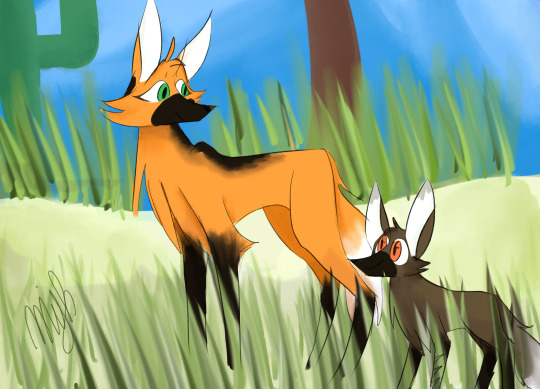
these are maned wolves (my ocs from wolfwalker ) and are not a mother and her cub, but two friends. 👍🥰😁🧡
about maned wolf:

Guara wolf From Wikipedia, the free encyclopedia How to read a taxonomy infoxoxy-maned wolf [1] Occurrence: Pleistocene - Recent Maned wolf in the Serra da Canastra National Park Maned wolf in the Serra da Canastra National Park conservation state Almost threatened Almost threatened (IUCN 3.1) [2] Scientific classification Kingdom: Animalia Phylum: Chordata Class: Mammalia Order: Carnivora Family: Canidae Genre: Chrysocyon Smith, 1839 Species: C. brachyurus Binomial name Chrysocyon brachyurus Illiger, 1815 Type species Canis jubatus Desmarest, 1820 Geographic distribution Maned Wolf range.png Synonyms [3] Canis brachyurus Illiger, 1811 Canis campestris Wied-Neuwied, 1826 Canis isodactylus Ameghino, 1909 Canis jubatus Desmarest, 1820 Vulpes cankerosa Oken, 1816 The maned wolf (scientific name: Chrysocyon brachyurus) is a species of canid endemic to South America and the only member of the genus Chrysocyon. Probably the closest living species is the vinegar dog (Speothos venaticus). It occurs in savannas and open areas in central Brazil, Paraguay, Argentina and Bolivia, being a typical animal of the Cerrado. It was extinct in part from its occurrence to the south, but it must still occur in Uruguay. On July 29, 2020 the maned wolf was chosen to symbolize the two hundred reais bill.
It is the largest canid in South America, reaching between 20 and 30 kg in weight and up to 90 cm at the height of the withers. Its long, slender legs and dense reddish coat give it an unmistakable appearance. The maned wolf is adapted to the open environments of the South American savannas, being a twilight and omnivorous animal, with an important role in the dispersion of seeds of fruits of the cerrado, mainly the lobeira (Solanum lycocarpum). Lonely, the territories are divided between a couple, who are in the period of the female's estrus. These territories are quite wide, and may have an area of up to 123 km². Communication takes place mainly through scent marking, but vocalizations similar to barking also occur. Gestation lasts up to 65 days, with black newborns weighing between 340 and 430 g.
Despite not being considered in danger of extinction by the IUCN, all the countries in which it occurs classify it in some degree of threat, although the real situation of the populations is not known. It is estimated that there are about 23 thousand animals in the wild, being a popular animal in all zoos. It is threatened mainly because of the destruction of the cerrado to expand agriculture, pedestrian accidents, hunting and diseases caused by domestic dogs. However, it is adaptable and tolerant of changes caused by humans. The maned wolf currently occurs in areas of Atlantic Forest already deforested, where it did not originally occur.
Some communities carry superstitions about the maned wolf and may even harbor a certain aversion to the animal. But in general, the maned wolf provokes sympathy in humans and is therefore used as a flag species in the conservation of the Cerrado.
Index 1 Etymology 2 Taxonomy and evolution 3 Geographic distribution and habitat 4 Description 5 Behavior and ecology 5.1 Diet and foraging 5.2 Territory, area of life and social behavior 5.3 Reproduction and life cycle 6 Conservation 7 Cultural aspects 7.1 Representations in cash 8 References 9 External links Etymology The maned wolf is also known as maned, watered, aguaraçu, mane wolf, mane wolf or red wolf. [4] [5] The term wolf originates from the Latin lupus. [4] Guará and aguará originated from the Tupi-Guarani agoa'rá, "down hair". [6] Aguaraçu came from the term for "guará grande". [4] Tupi-Guarani names of origin are more common in Argentina and Paraguay (aguará guazú), but other Spanish-speaking countries have other names like boroche in Bolivia and wolf of crin in Peru. [7] Lobo de crin (in Spanish) and maned wolf (in English) are allusions to the mane of the nape of the neck. [7]
Taxonomy and evolution
It is one of the endemic canids of South America. Phylogenetic relationships of South American canids. [8]
Chrysocyon brachyurus - maned wolf
Speothos venaticus - vinegar dog
Atelocynus microtis - short-eared bush dog
Cerdocyon thous - bush dog
Lycalopex genus - South American foxes
Phylogeny inferred from mitochondrial and nuclear DNA data. The species was described in 1815, by Johann Karl Wilhelm Illiger, initially as Canis brachyurus. [3] Lorenz Oken classified it as Vulpes cancosa, and only in 1839, Charles Hamilton Smith described the genus Chrysocyon. [3] Later, other authors considered him to be a member of the genus Canis. [3]
Despite having belonged to the genera Canis and Vulpes, due to their morphological similarities, the maned wolf is not closely related to these genera. [9] Molecular studies have shown no relationship between the Chrysocyon genus and these canids. [8] [10] The maned wolf is one of the endemic canids of South America, along with the bush dog (Cerdocyon thous ), the vinegar dog (Speothus venaticus) and the genus Lycalopex. [8] Such a group is monophyletic according to genetic studies, but morphological studies include Nyctereutes procyonoides, who is originally from Asia. [8]A study comparing the brain anatomy of several canids, published in 2003, placed the maned wolf as akin to the falkland fox (Dusicyon australis) and the genus Lycalopex (considered by the authors as Pseudalopex). [11] Molecular studies corroborate that the maned wolf has a unique common ancestor with the falkland fox, which lived approximately 6 million years ago. [12] [13]However, recent genetic studies place the maned wolf as the closest phylogenetically to the vinegar dog (Speothos venaticus), forming a clade that is a sister group to another to which all other South American canids belong, such as the canine dog. short-eared bush (Atelocynus microtis), the bush dog (Cerdocyon thous) and the genus Lycalopex. [8] [10] This clade diverged from other South American canids about 4.2 million years ago, and the Chrysocyon and Speothos genera diverged about 3 million years ago. [8]Not many maned wolf fossils are known and those that were discovered originate from the Holocene and the Upper Pleistocene, unearthed in the Brazilian plateau, indicating that the species also evolved only in the open areas of Central Brazil. [14] Nor are subspecies recognized. [15]Geographic distribution and habitatThe Cerrado is the main habitat of the maned wolf. The maned wolf is an endemic canid from South America and inhabits the grasslands and thickets of the center of that continent. Its geographic distribution extends from the mouth of the Parnaíba River, in the Northeast of Brazil, through the lowlands of Bolivia, east of the Pampas del Heath, in Peru and the Paraguayan chaco, to Rio Grande do Sul. [3] Evidence of the maned wolf's presence in Argentina can be found up to Parallel 30, with recent sightings in Santiago del Estero. [2] Probably the maned wolf still occurs in Uruguay, given that a specimen was spotted in 1990, but since then there has been no record of the species in the country. [2]It is a fact that the maned wolf has disappeared in many regions at the southern limits of its geographical distribution, occurring almost only up to the border of Rio Grande do Sul with Uruguay. [16] Interestingly, the deforestation of the Atlantic Forest in the southeastern and eastern regions of Brazil favored the expansion of its geographic distribution to areas where it did not previously inhabit. [16] For this reason, records in Atlantic Forest areas in Paraná, São Paulo, Rio de Janeiro and Minas Gerais have increased in recent years. [5] In the Pantanal the maned wolf occurs in highlands in the upper Paraguay, but avoids the lowlands of the Pantanal plain. [5] There are sporadic records of the species in transition areas between the Cerrado and the Amazon and the Caatinga. [5] The species can occur above 1,500 meters in altitude. [5]The maned wolf habitat is mainly characterized by open fields, with shrub vegetation and forest areas with open canopy, being a typical animal of the Cerrado. [15] It can also be found in areas that experience periodic flooding and man-made fields. [15] The maned wolf prefers environments with a low amount of shrubs and sparse vegetation. [15] More closed areas are used for rest during the day, especially in regions that have been greatly altered anthropically. [17] In these altered areas it can be seen in cultivated fields, Eucalyptus plantations and even in suburban areas. [18] Although the species can occur in anthropic environments, further studies are needed to quantify the degree of tolerance of the maned wolf to agricultural activities, but some authors suggest the preference for areas modified by man as opposed to well-preserved forest areas. [5] [15]DescriptionThe skull is similar to that of the wolf and the coyote. It is the largest canid in South America, reaching between 95 and 115 cm in length, with a tail measuring between 38 and 50 cm in length and reaching up to 90 cm at the height of the withers. [15] It weighs between 20.5 and 30 kg, with no significant differences in the weight of males and females. [15] It is an animal difficult to confuse with other South American canids, because of its long and thin legs, dense reddish coat and large ears. [15] The species' slender shape is probably an adaptation to displacement in open areas covered by grasses. [3]It is unmistakable among South American canids, being the largest among them. The body coat varies from golden red to orange and the hairs on the back of the neck and feet are black, with no undercoat in the coat. [3] The lower part of the jaw and the tip of the tail are white. [3] The hairs are long, reaching up to 8 cm in length along the body, forming a type of mane on the animal's neck. [7] There is almost no variation in the color of the coat, and it is not possible to identify individuals or sex from hair color, although an entirely black individual has already been recorded in northern Minas Gerais. [7] [19]The shape of the head looks like that of a fox. The snout is slender and the ears are large. [3] However, the skull is similar to that of the wolf (Canis lupus) and the coyote (Canis latrans). [3] The skull also has a prominent sagittal crest. The butcher tooth is reduced, the upper incisors small and the canines long. [3] Like the other canids, it has 42 teeth with the following dental formula: {\ displaystyle {\ tfrac {3.1.4.2} {3.1.4.3}} \ times 2 = 42} \ tfrac {3.1.4.2} {3.1.4.3} \ times 2 = 42 [20] Similar to the vinegar dog (Speothos venaticus), the maned wolf's rhyme extends to the upper lip, but the vibrissae are longer. [3]The maned wolf's footprints are similar to those of the dog, but have the pads disproportionately small when compared to the digits of the digits, which are wide open. [21] [22] The dog has foot pads up to 3 times larger than the maned wolf's footprints. [22] These pillows are triangular in shape. [22] The front footprints are between 7 and 9 cm long and 5.5 and 7 cm wide, and those on the back legs are between 6.5 and 9 cm long and 6.5 to 8.5 cm wide. [22 ] A characteristic that differentiates the maned wolf's footprints from that of other South American canids is the proximal union of the third and fourth digits. [3]Geneticame n the maned wolf has 38 chromosomes, with a karyotype similar to that of other canids. [3] Genetic diversity suggests that 15,000 years ago the species suffered a reduction in its diversity, called the bottleneck effect. Even so, this genetic diversity is greater than that of other canids. [5]average 0.7 seconds in 2 to 4 second intervals, a sequence that is repeated for up to 23 times. [7] Both males and females vocalize. [7] They tend to vocalize more at night, when they can be heard from several meters away. [35] Despite being associated with territoriality, vocalizations are more frequent among young people from the same territory, suggesting that they are only a sign for contact over great distances between known individuals and not for the defense of territory. [35]Direct social interactions are rare and maned wolves seem to avoid each other. [7] Agonistic encounters are rare but occur mainly between males, and have not been seen among females. [32] This results in almost no overlap in the male territories. [32]
Reproduction and life cycle
The puppies are born weighing between 340 and 430 g and have a reddish coat after the tenth week As in the diet, most of the data on the maned wolf's estrus and reproductive cycle comes from animals in captivity, mainly on the endocrinology of reproduction. [33] However, studies of animals in freedom have found that hormonal changes follow the same pattern of variation as animals in captivity. [33] At first females spontaneously ovulate, but some authors suggest that the presence of a male is important for estrus induction. [33]
Captive animals in the northern hemisphere breed between October and February and in the southern hemisphere between August and October. This indicates that the photoperiod has an important role in the reproduction of the maned wolf, mainly due to the production of semen. [3] [33] Usually estrus occurs annually [3] and the amount of sperm produced by the maned wolf is less when compared to that of other canids. [33]
Copulations take place during the 4-day period of estrus and are followed by up to 15 minutes of copulatory engagement. [3] The courtship behavior is no different from that of other canids, characterized by frequent approximations and anogenital investigation. [26]
The gestation lasts about 65 days, being born between 2 and 5 puppies, but 7 puppies have already been registered. [3] Births in May have already been observed in the Serra da Canastra, but captivity data suggest that births are concentrated between June and September. [5] The few data available on reproduction in the wild show that the maned wolf reproduces with difficulty and the mortality of young is high. Females can stay up to 2 years without reproducing. [33]
In captivity, reproduction is even more difficult, especially in temperate countries in the northern hemisphere. [33] The puppies are born weighing between 340 and 430 grams, black and changing to a reddish color after the tenth week. [3] The eyes open at about 9 days of age. [3] They are breastfed up to 4 months and fed by their parents through regurgitation until 10 months, starting at the 3rd week of age. [25] [26] At three months of age the puppies accompany the mother while she forages. [25] Parental care is shared between male and female, but females do this more often. [25] Data on male parental care have been collected from captive animals, and little is known about whether this occurs frequently in wild animals. [26] Sexual maturity is reached at 1 year of age and after that age they leave the territory in which they were born. [26]
youtube
#lobos#lobo guará#lobos guarás#guara wolf#wolf#wolf art#wolf oc#my wolf#lobos oc#my drawimg#drawing#drawing cute#my drawing#digital art#my oc digital#digital#art digital#art#my art#my oc#my oc art#oc#ocs#wolfwalkers#wolfwalkers oc#wolfwalkers ocs
29 notes
·
View notes
Text
Research: Project Finish
Tim Sale
Tim Sale is a famous comic book artist, who had worked in several titles along with the writer Jeff Loeb, including Batman, Spider-Man, Superman, Daredevil, and many others.
Tim Sale was born in may of 1956, in New York, where he studied visual arts, spent a good time of his life in Seattle, and today he lives in California.
For some years he drew his art privately, only to please himself. When he found himself working at a fast food in his late twenties, however, he decided to try to sell some of his work. This led to an association with Thives’ World Graphics, a fantasy anthology series, where he illustrated stories.
What most marks his work is the dramatic aspect that he manages to obtain in the characterization of his characters and in the scenarios he creates, making the stories unique and immortalizing the characters.
The union of Sale’s art with Loeb’s engaging narrative has become the perfect marriage for mysterious plots.
One of the most striking characters worked by Sale was Batman, which he drew “The Long Halloween”, “Dark Victory” and “Halloween”. He was able to fully transfigure the dark aura of Gotham and his Dark Knight. He also worked with Superman in the saga “ Superman for All Seasons”.
Both of The Long Halloween and For All Seasons are what is known as “Year one” comics. These works take their heroes back in time to their earliest days of crime fighters.
His main tool is watercolor, which he uses with mastery. Sale's palette of colors is something really impressive, always drawing and painting his characters very delicately, and calmly. His style is very cartoonish, although this does not diminish his art in any way, on the contrary, his style is very unique and characteristic.
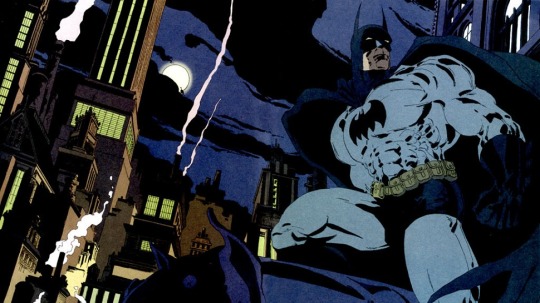
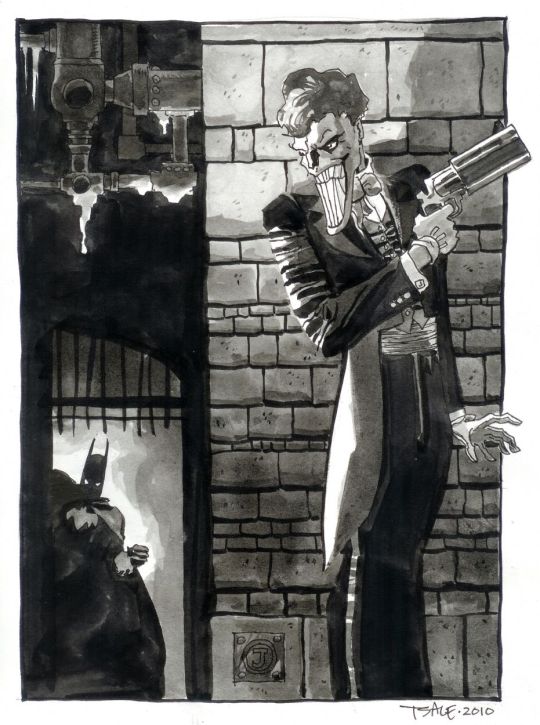


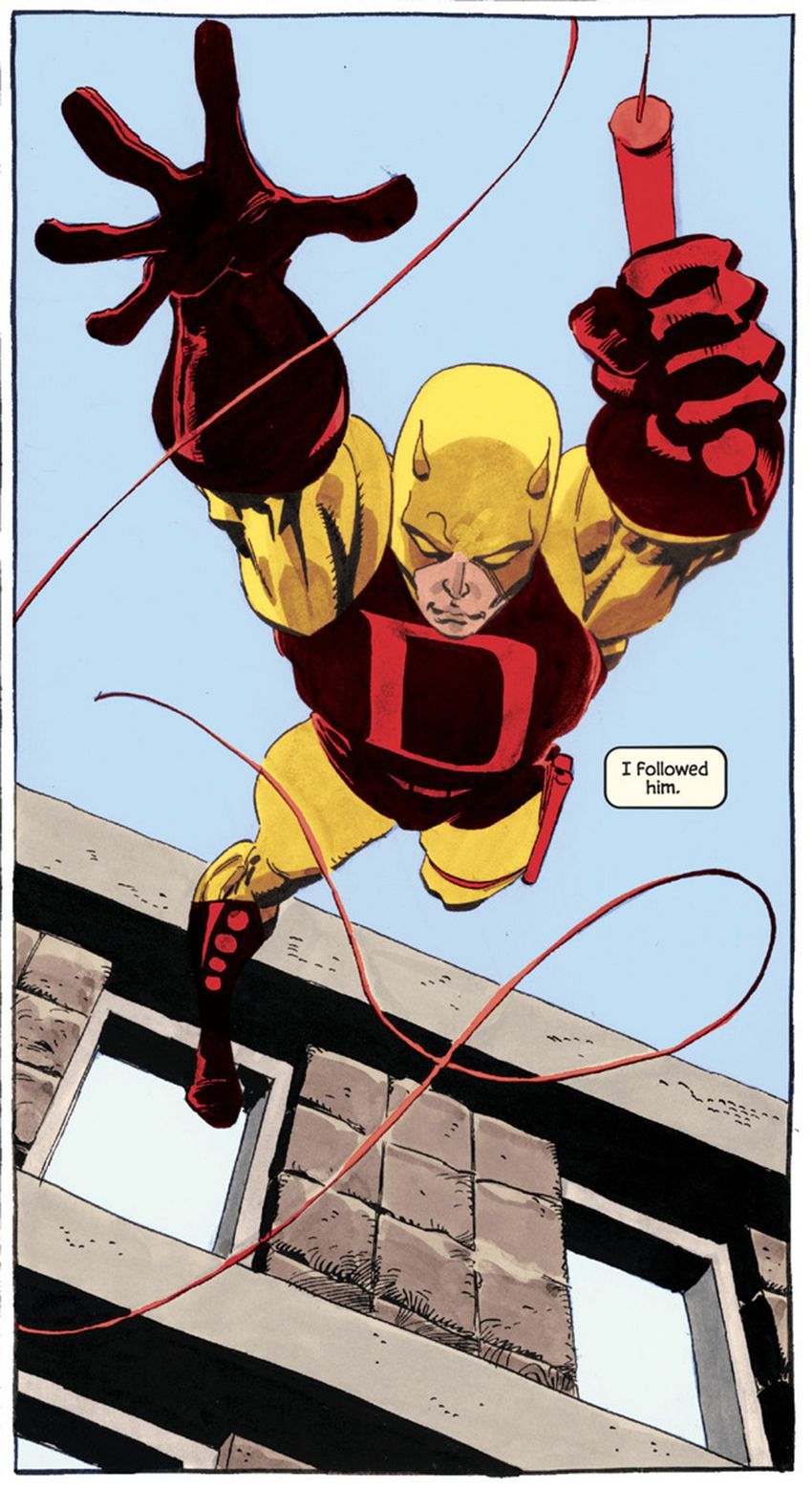
Pedro Franz
Is a Brazilian comic book artist, who was born in Santa Catarina and has a degree in design.
He has been publishing several comic books and participating in exhibitions in Brazil and abroad. As an illustrator, he has published works several magazines and books, and regularly collaborates with the Piauí magazine. As a graphic designer, he is a contributor to the Par (Ent) Esis platform. He has comics translated and published in English and Spanish, and has good international recognition, thanks to his publications.
But what is most impressive in Pedro's art, perhaps is his intensive use of colors. Mixing various shades of different colors, mixing different compositions. In addition to sometimes using characters from pop culture, with his elaborate style.
Despite liking traditional comics, he has always published and worked for national publishers, often with authorial works.
Perhaps his best known work, which was even published in the United States is the comic “Suburbia”.
Suburbia tells the story of Conceição, a girls daughter of enslaved rural workers, who flees to Rio de Janeiro in the early 1990s. In the city, Conceição begins to work as a cleaner and to get involved in the world of funk, slums and poverty.
His drawings are extremely surreal, not exactly following a traditional way of making comics, with several images spread across the page, with different shapes and sizes, with extremely strong colors, mainly valuing blue, purple, yellow and red, as his main colors.
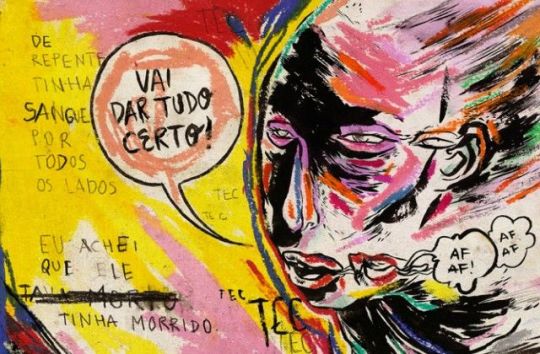
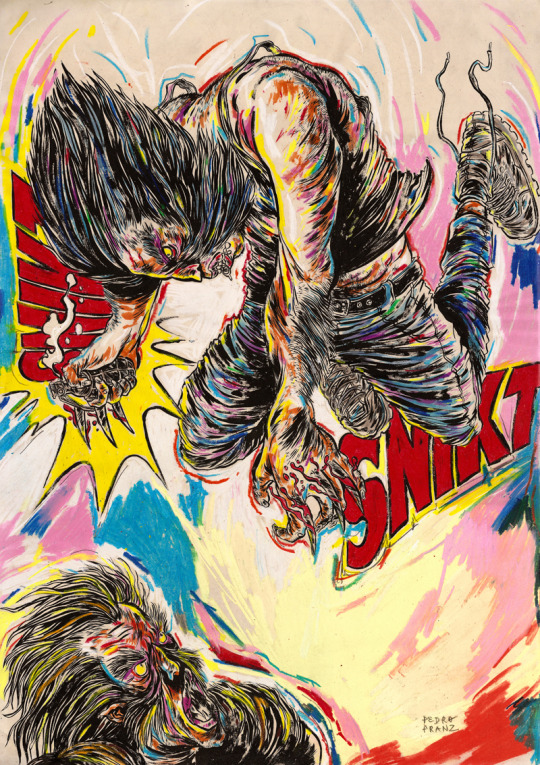
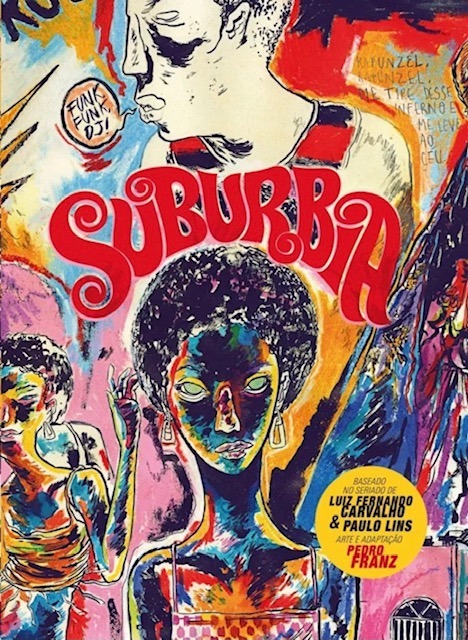

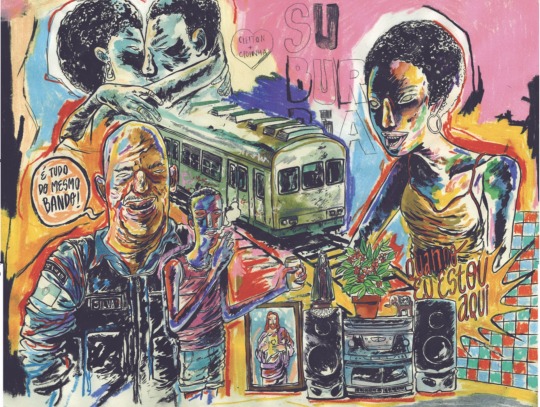
Richard Corben
Richard Corben was one of the contributors of elevating the comics to the category of Art, and of its unparalleled style of great influence among many current artists.
Richard Vance Corben was born in Missouri, United States on October 1940, in a family of farmers in the middle west ( where he started reading comics), and lived in Kansas City. There he studied Fine Arts, got married, had a girl and started working in local cinematography animation company. At the same time, he started to create and publish some underground fanzines. From the begging it was clear that he was interested in science fiction, eroticism, and total rejection of institutions ( the Army, the Church, etc), mixed with a lot of humor.
At a young age, Corben was an aficionado of bodybuilding, just like everyone who was interested in a persons aesthetics. The first character that he created, was Rowlf, a dog who took on a human form. In the beginning of the 1970s he amplified his work ( and his fame) in some underground magazines. And in 1971 he started working for the Heavy Metal publisher where he created one of his most famous characters, Den a large muscular man, who was always naked, and always after some adventure.
Corben has a very particular style, with unsettling mixture of caricatured, often satirical grotesque and intense,convincing realism. Never before had such wildly cartoonish worlds proved so convincing.
Also he can handle an exponentially higher standard because of his ability to use colour to show the effect of light on whatever he’s depicting. The way that he mixes light and colors in certain panels to differentiate those elements from each other, is something to admire.
Corben worked in a few mainstream comics, he always preferred to work with authorial works or working in specific themes like fantasy and science fiction comics and not so much on superheroes.
But probably the most famous mainstream comic that ever worked was the character Hellboy, along with writer Mike Mignola.
Hellboy is a series of comics that has a lot of mysticism, Norse mythology, horror and monsters. Something Corben certainly agreed to do, without thinking twice.
Richard Corben is one of my favorite artists, with a style that is perhaps not as realistic as an Alex Ross for example, but the humor and beauty that he puts in his characters is very unique.
Corben died on December 2, 2020, leaving a great legacy, for the world of comics and arts, with a very unique style and extremely stunning worlds.
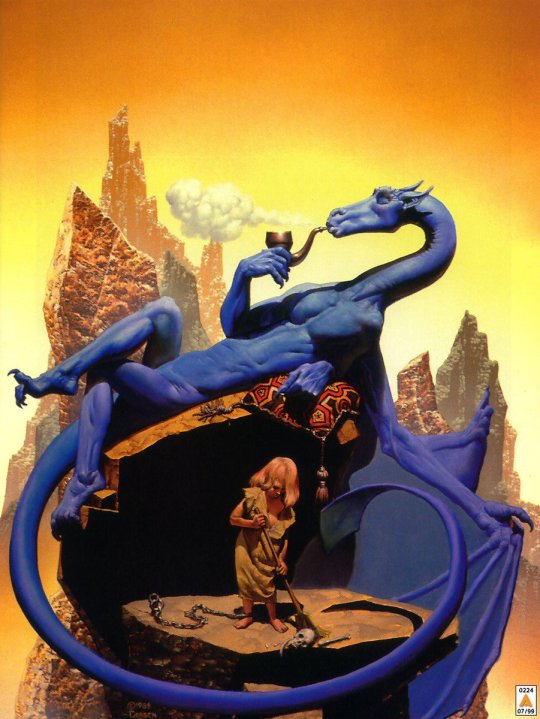
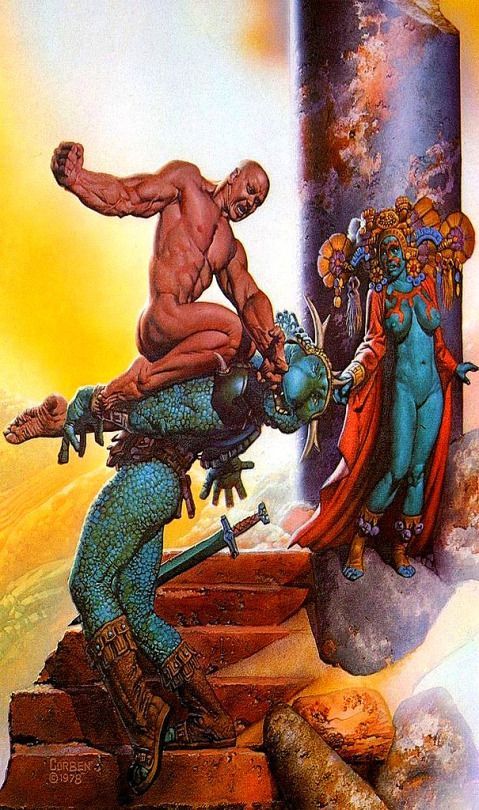
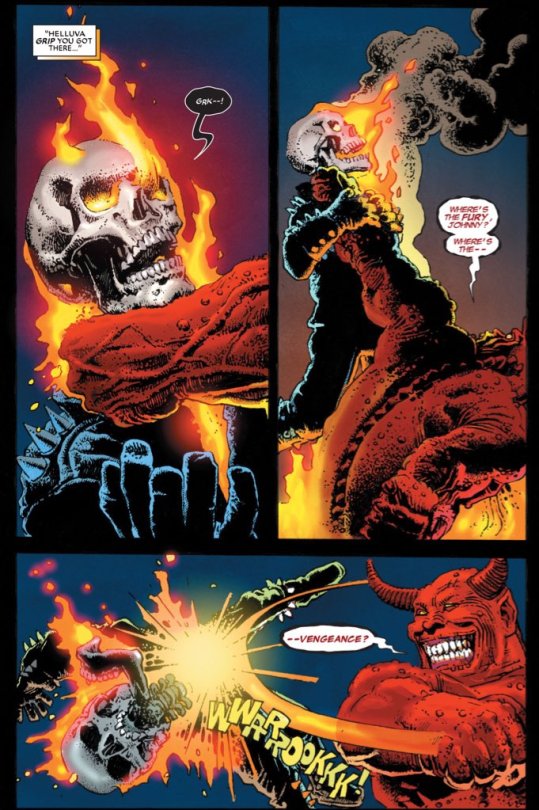
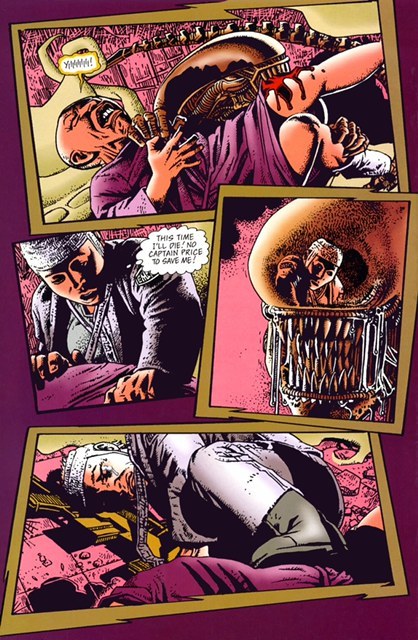
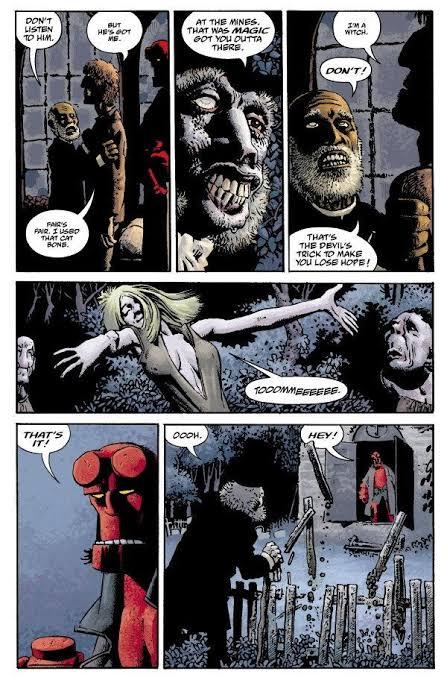
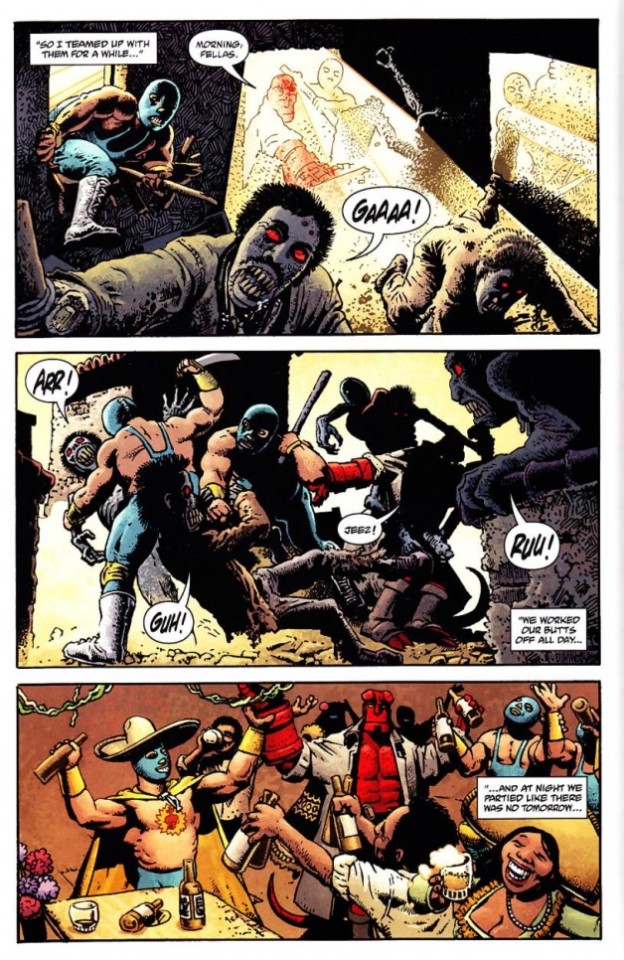
Charlie Allard
Charlie Adlard is a British comic book artist, who have worked on the comic industry for over 25 years. He spent the majority of his time since 2003 working in The Walking Dead along side with writer Robert Kirkman , until the last issue on 2019 He started reading comics when he was very young, and he said that he was very lucky to have influences of American comics and the more high art, such as Asterix and Tin Tin. He was fascinated by European comic books artists like Moebius, Alberto Uderzo and Herge. He started his career as many British artists and writers, working on 2000 AD, with characters such as Judge Dredd, Armitage and eventually Savage. In the United States he started working with the X Files, Astronauts in trouble, and of course The Walking Dead. Adlard started in The Walking Dead from issue 7, and brought a slightly different style, from the previous artist. Adlard's art is very cartoonish, but the universe of The Walking Dead still doesn't get silly because of it. Quite the opposite, the dirt and rot that Adlerd puts on his characters and the world, only sustains what a horrible world it is to live in. Many readers complain about Adlard's style, being very simple, that his characters are very similar, and sometimes it is difficult to identify them. But I believe that although his style does not vary much, when it comes time to show a horde of zombies, a devastated city, people feeling despair, and extremely disturbing scenes, Adlard manages to excel. Adlard's main tool is ink. All The Walking Dead magazines are in black and white, and he manages to give a lot of depth to the scenarios and characters using only a few ink stains. Today Adlard is doing some comics, mainly for DC, but says that he does not intend to work with Kirkman and zombies again, because he wants to explore other themes, and to innovate his drawing skills.
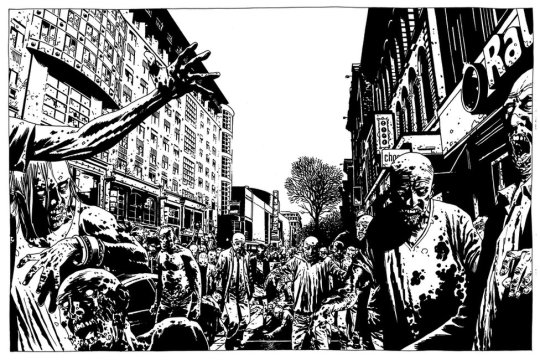
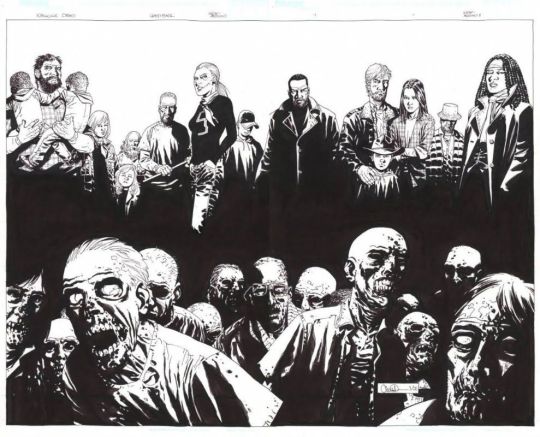
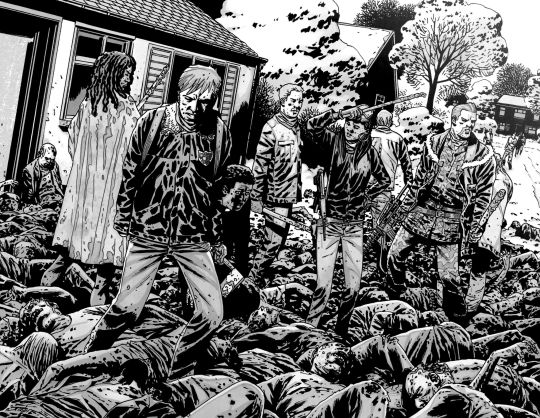
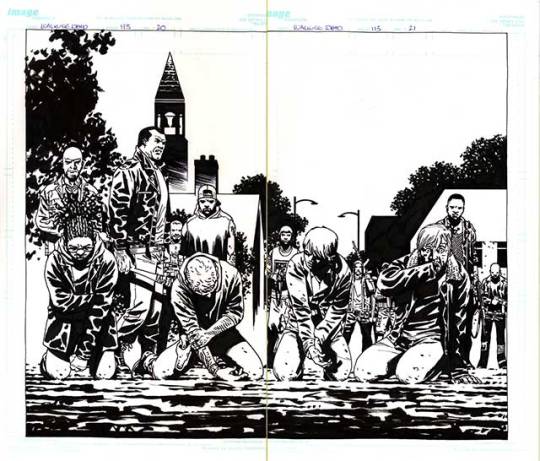
Zaha Hadid
Zaha Hadid was one of the most important and well known figures in contemporary architecture and design. With a singular trajectory, marked by a versatile, bold and out of the box style, she was the first woman to receive Pritzker Prize for architecture and was also the only female representative honored by the Royal Institute of British Architects with a golden medal. Zaha Hadid was born in Iraq, more precisely in the city of Halloween, in Bagdá, in the year 1950. Her family was of high class, her father being an important politician and her mother an artist. Still young, she traveled and studied in other places of the world, like London and Switzerland, but it was in her native land the she got her first formation, when she graduated in mathematics. At the age of 22, in 1972, she enrolled in one of the most famous independent schools of architecture in London, and there she gave the starting point to her career by studying and creating an important connection with the Dutch architect Rem Koolhaas, a figure that encouraged her and opened the doors for opportunities. Later in the 1980s, Zaha Hadid decided to open her own office. This, Zaha Hadid Architects was born, which made her name and talent recognized worldwide. Known for her works with futuristic lines, clean and pure forms, as well as the fragmentation of architectural design. Her projects and discussions raise issues that put architecture and its future to the test. This is because the architect seeks in her works to interrelate design, architecture and urbanism. I knew Hadid and some of her works, but it was the recommendation of my teacher Lauren, that I should look for this architect. As my project takes place in the future, she recommended that I look at some works by Zaha Hadid to get inspiration when creating the scenario for the comic. I find it very interesting how her works have this futuristic aesthetic , because it reminds me of science fiction films like Blade Runner with those skyscrapers and buildings with different shapes and sizes that are extremely imaginative that could only exist in films. With unique works and projects, famous for their exuberance, futuristic elements, curves, non linear shapes, distortions and fragmentations, Hadid inspired and generated fascination both for her constructions around the world.




Syd Mead
Syd Mead was a designer, best known for working on films such as Aliens, Blade Runner, Tron and Star trek. Mead was born in Minnesota, United States, on July of 1933, but five years later he moved to a second house in the western of United States prior to graduating from High School in Colorado in 1951. Some years later, he did the Art Center School in Los Angeles, where he graduated with great distinction in 1959. He was immediately recruited by the Ford Motor Company. At Ford he worked in the advanced styling department, creating futuristic concept car designs. But his imagination went beyond cars and he began to imagine clothes, helmets, buildings and scenery from hyper advanced civilization. After Ford, he also worked in other big companies like Chrysler, Sony and Phillips. After that he started migrating to the concept art world of movies. Mead is really important for generation of writers of science fiction, because many of them were influenced by Mead’s colorful paintings. Mead never wrote a novel or short story. He imagined the future in his mind and turned that imagination into illustrations. In 1979 he designed the extraterrestrial spaceship for the first film “Star Trek” in the cinema. Ridley Scott called Mead to design the buildings and flying cars of the futuristic Los Angeles “Blade Runner” in 1982. In 1986 he was hired to design the space station and vehicles of the movie Aliens directed by James Cameron. Almost at the same time, the designer created the electronic world of “Tron” for Disney studios. The same ones who hired him in 2014 to design the futuristic city of “Tomorrowland”. Mead died in 2019 after three years of lymphoma, he was 86 years old. He was a great influence for many designers and science fiction writers and illustrators, due for his creative worlds and automobiles , Elon Musk quotes Mead as one of his major influences, on visions of the automotive future and design in general.
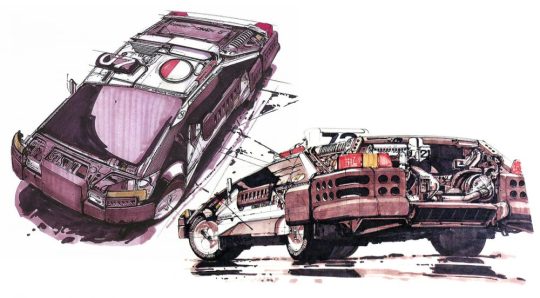
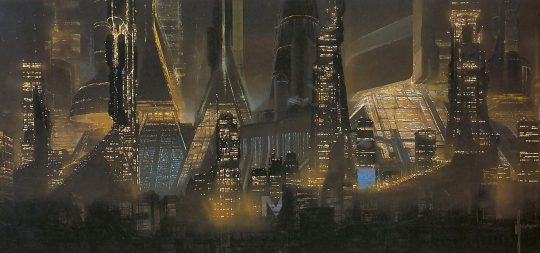
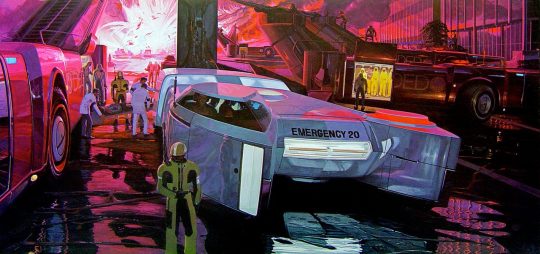


Transmetropolitan by Warren Ellis and Darick Robertson
Transmetropolitan is a comic written by the British writer Warren Ellis and the American illustrator Darick Robertson, published by the Vertigo label, and falls within the cyberpunk genre, and the problems that rampant technology will cause us.
Throughout the 60 issues of Transmetropolitan, Ellis and Robertson build a chaotic and brilliantly alive future, presenting a sci-fi society with a peculiar mix of elements of cyberpunk, political dystopias, bioengineering and transhumanism, sexuality, economics and much more.
In a dystopia, in a not so distant future, the journalist Spider Jerusalem is isolated for fiver years in a hut in the forest, but he has to return to the city to earn some money.
Throughout the comic, amid a nihilistic aura that humanity has no salvation, the author- Warren Ellis - criticizes the consumerism and futility. The illustrations, of Darick Robertson, is full of excesses as the environment should be, a brand of the style of the 1990s.
The search for the truth is the central theme of this work, and in the midst of all this we found ourselves in a investigative odyssey that involves the lowest scum of that society ( thieves, murderers and rapists) until reaches the highest of the scum ( the presidency).
This background allows the work to touch on the most profound social themes, and without fear of saying what needs to be criticized, this is where Transmetropolitan shines, and provoke deep reflections on issues such as racism, the influence of media, the power of religions, the education, and many other themes.
In short, Transmetropolitan dissects and criticizes everything, it points out the flaws, the lies and the hypocrisy of each one. It’s a study about the problems of democratic society in the 21th century.
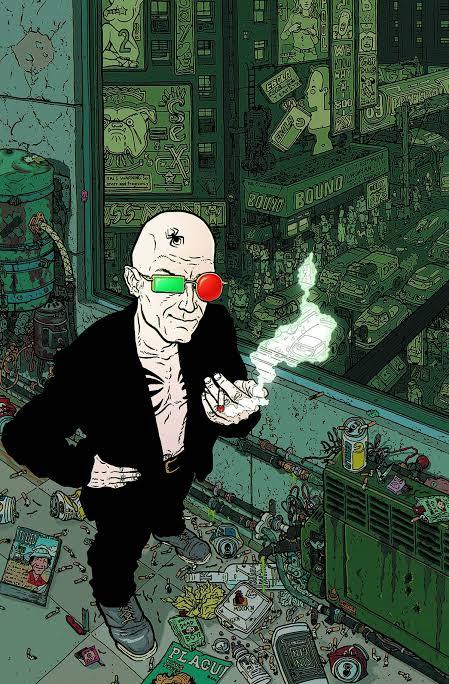
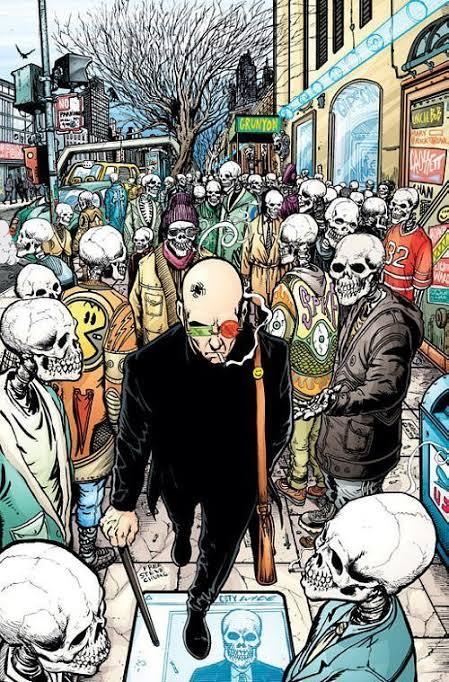
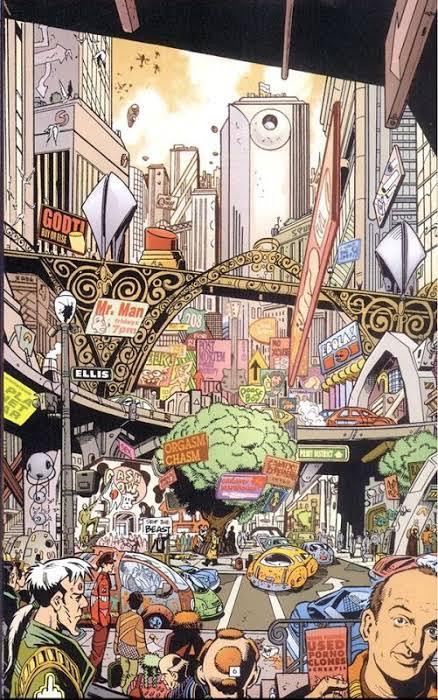
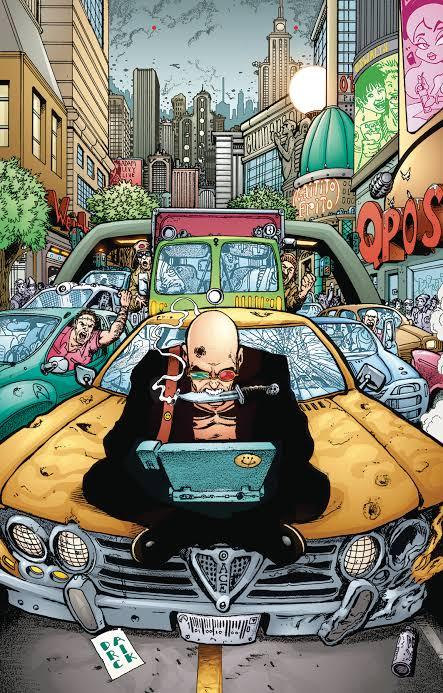
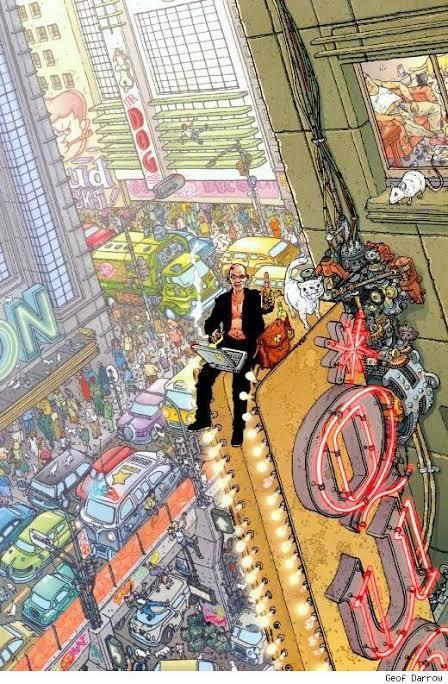
Jon Mcnaught
Jon Mcnaught was born in 1985, London, England. He work with drawing comics, and work as an illustrator, printmaker and lecturer. After spending several years on the Falkland Islands during his childhood, which will inspire his second book, Pebble island. The book pass years after the war, where he tries to recreate his childhood, with aspects of his curiosity, when he was exploring abandon bunkers, where it was just part of landscape, or somewhere where he could play. His work has essentially been landscape print-making (often situated in the city), but with quite simple intention of capturing the sense of space, light, time etc. His work is mostly about that, places that he was interested in depicting, and trying to reproduce the visual. He want the characters to feel like elements of a landscape or an environment ( he preferes to focus more on the background, than the characters itself). But usually he uses figures and postures to suggest expressions rather than close ups showing facial features. What I like about Mcnaught's work is that they are simple designs, but the colors are very vivid. The way he constructs the scenarios is very invective, because it doesn’t need to be extremely detailed, he just needs a few lines to show what he is talking about.
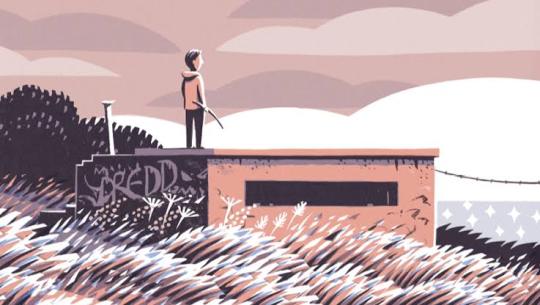



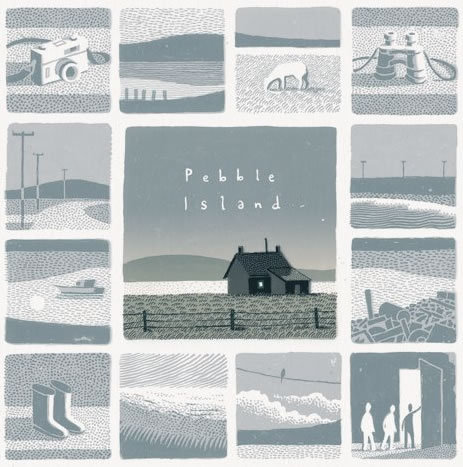
13 notes
·
View notes
Text
Puerto Rican migration to Hawaii began when Puerto Rico's sugar industry was devastated by two hurricanes in 1899. The devastation caused a worldwide shortage in sugar and a huge demand for the product from Hawaii. Consequently, Hawaiian sugarcane plantation owners began to recruit the jobless, but experienced, laborers in Puerto Rico.
In the 19th century, Puerto Rico depended mainly on its agricultural economy. The island together with Cuba was the Spanish Crown's leading exporter of sugar, coffee, tobacco and cotton. When the island was ceded to the United States after the Spanish–American War, as stipulated by the agreements of the Treaty of Paris of 1898, most of its industries were taken over by American industrialists. Cheap labor was provided by Puerto Ricans who depended on the nation's agriculture as their only source of income.[1]
On August 8, 1899, Hurricane San Ciriaco, with winds of over 100 miles per hour, struck Puerto Rico and, on August 22, another hurricane followed. The floods, caused by 28 days of continuous rain, damaged the agricultural industry and left 3,400 dead and thousands of people without shelter, food or work.[2] As a result, there was a shortage of sugar from the caribbean in the world market and a huge demand for the product from Hawaii and other sugar producing countries. To meet the demand, plantation owners began a campaign to recruit the jobless laborers in Puerto Rico.[3] On November 22, 1900, the first group of Puerto Ricans consisting of 56 men, began their long journey to Maui, Hawaii. The trip was long and unpleasant. They first set sail from San Juan harbor to New Orleans, Louisiana. Once in New Orleans, they were boarded on a railroad train and sent to Port Los Angeles, California. From there they set sail aboard the Rio de Janeiro to Hawaii.[4] According to the "Los Angeles Times" dated December 26, 1901, the Puerto Ricans were mistreated and starved by the shippers and the railroad company. They arrived in Honolulu, on December 23, 1900, and were sent to work in one of the different plantations owned by the "Big Five" on Hawaii's four islands.[5] By October 17, 1901, 5,000 Puerto Rican men, women and children had made their new homes on the four islands. Records show that, in 1902, 34 plantations had 1,773 Puerto Ricans on their payrolls; 1,734 worked as field hands and another 39 were clerks or luna/overseers (foremen). The "Big Five" was the name given to a group of sugarcane corporations that wielded considerable political power in the Territory of Hawai‘i and leaned heavily towards the Hawai‘i Republican Party. The "Big Five" consisted of Castle & Cooke, Alexander & Baldwin, C. Brewer & Co., Amfac and Theo H. Davies & Co..
The owners of the "Big Five" were Euro-Americans who would indulge in discrimination and bigotry against ethnic groups who worked the plantations. They had an association called the "Hawaiian Sugar Planters Association" (HSPA) whose power could be considered as equivalent to an oligarchy. The Attorney General of Hawai‘i, referring to the Big Five, said in 1903, "There is a government in this Territory which is centralized to an extent unknown in the United States, and probably almost as centralized as it was in France under Louis XIV."[6] Wages and living accommodations depended upon their job and race. Europeans were paid more and received better quarters. Most of the workers moved from plantation to plantation to work because they did not like the work they did and because of the racial discrimination.[7] According to the State of Hawaii Data Book 1982, by the year 1910, there were 4,890 Puerto Ricans living in Hawaii.[8] Puerto Rico and Hawaii were unincorporated and incorporated territories of the United States respectively; however, the passage of the Jones–Shafroth Act of 1917, the same year that the United States entered World War I, gave American citizenship, with limitations, to the Puerto Rican resident in Puerto Rico and excluded those who resided in Hawaii. Yet, the "non-citizen" Puerto Ricans were assigned draft numbers and were expected to serve in the military.[9]
The Plantation owners, like those that comprised the "Big Five", found territorial status convenient, enabling them to continue importing cheap foreign labor; such immigration was prohibited in various other states of the Union.[10] In 1917, Puerto Ricans in the island, believing that they were entitled to the same rights that every other U.S. citizens had, tried to sign up to vote in a local Hawaiian election and were denied their rights by the county clerk who claimed that early immigrants to Hawaii were not covered by the Jones Act.[9]
Manuel Olivieri Sanchez, a court interpreter at the time, became enraged in what he viewed as a violation of the civil rights of his fellow countrymen. He encouraged his fellow Puerto Ricans to protest by telling them that "If you are not allowed to vote, don't answer the draft call".[9] Olivieri Sanchez led a legal battle for the recognition of the Hawaiian Puerto Ricans as citizens of the United States. In the first legal battle the lower court ruled in favor of the county clerk, however Olivieri Sanchez did not give up the fight and took the case before the Territorial Supreme Court, which reversed the decision of the lower court, granting the Puerto Ricans of Hawaii their United States citizenship.[11] Olivieri Sanchez' victory was not welcomed by members of HSPA, who depended on the cheap labor non-citizens provided. In 1930, HSPA began to circulate false rumors, they made it be known that they (HSPA) were planning to recruit laborers in Puerto Rico, while at the same time they had the "Honolulu Star Bullentin" and some local newspapers they controlled run anti-Puerto Rican stories, that—for example—claimed Puerto Ricans were "unhealthy hookwormers who had bought disease to Hawaii".[9]
In December 1931, Olivieri Sanchez wrote a letter to the editor of the Hawaiian Advertiser where he stated that he saw all of the rhetoric as a tactic by HSPA to push all the different ethnic groups in the local labor force back to work on the plantations. He was right, the HSPA wanted to persuade the United States Congress to exempt the territory from a law, which in 1924 was requested by California to prevent the migration of Filipinos and Japanese nationals to the U.S. (National Origins Quota Action (Immigration Act) and Johnson Immigration Act of 1924).[12] HSPA's secretary treasurer claimed that the association was unwilling to import Puerto Ricans to Hawaii. His defamation of Puerto Ricans condemned not only the Puerto Ricans of Hawaii, but also those on the island of Puerto Rico. Despite the efforts of Olivieri Sanchez, HSPA had their way and Hawaii was exempted from the stern anti-immigration laws of the time.[9]
The power of the plantation owners was finally broken by the activist descendants of the original immigrant laborers. Because it was recognized that they were born in an incorporated United States territory and that they were legal American citizens with full local voting rights and therefore were entitled to actively campaign for statehood recognition of the Hawaiian Islands.[13]
Currently, there are over 30,000 Puerto Ricans or Hawaiian-Puerto Ricans living in Hawaii. Puerto Rican culture and traditions are very strong there. One of the traditions that is still practiced is the "compadrazgo". When a person baptizes somebody's child, he or she becomes the "padrino" (godfather) of the child and the "compadre" or "comadre" of the child's parents. There is a relationship of respect, mutual affection and obligation between the child, parents and compadres. The children ask for a blessing "La Bendición" and the padrinos respond with a "Dios te bendiga" (God bless you).[4] During the late 20th century, the "coquí", a thumbnail-sized tree frog endemic to Puerto Rico, became established in Hawaii, most likely as stowaways in shippings of potted plants. Its loud mating call, "music to the ears" of Puerto Ricans on their native highland, is considered an annoyance in Hawaii where this invasive species reaches much higher population densities. Unsuccessful efforts were made to exterminate the infestation.[17][18]
4 notes
·
View notes
Text
Cordel literature

Cordel literature (from the Portuguese term, literatura de cordel, literally “string literature”, Portuguese pronunciation: [koʁˈdɛw]) are popular and inexpensively printed booklets or pamphlets containing folk novels, poems and songs. They are produced and sold in street markets and by street vendors in Brazil, mainly in the Northeast. They are so named because they are hung from strings to display them to potential customers, and the word for rope in Portuguese is corda, from which the term cordel is derived.
Cordel literature forms one of the least altered continuations of the Western traditions of popular literature, such as chapbooks, and popular prints. Its history dates back to the 16th century, when the printing of oral reports became popularized in the Renaissance. This genre derives from the papel volante tradition of Portugal, a literary genre also found in Spain during the 18th and 19th centuries, and offered readers a wide array of topics, from basic instruction to political tracts.The name comes from the way the leaflets were traditionally displayed for sale, hung on ropes, twine or string in Portugal. It remains a popular literary form in Brazil. In the Northeastern region of Brazil, the name was adopted, but the leaflet may or may not be displayed on string. Some poems are illustrated with woodcuts, also used on the covers.

(Woodcut by Yolanda Carvalho)
The most common stanzas are those of ten, eight or six verses. The authors, or cordelistas, recite these verses in a melodious and cadenced way, accompanied by a musical instrument named viola. Readings or declamations of these verses are performed to win over potential buyers. In 1988, the Academia Brasileira de Literatura de Cordel (ABLC) [Brazilian Academy of Cordel Literature] was founded in Rio de Janeiro in order to bring together the exponents of this Brazilian literary genre.
Some of the main authors from the past are Leandro Gomes de Barros (1865–1918)and João Martins de Athayde (1880–1959).
Today some Cordel Literature authors as Marcelo Soares, Davi Teixeira, Meca Moreco and Altair Leal are keeping this popular expression alive. Those writers and other authors are helping to show the importance of popular art to Brazil and to the world .
Usually produced in black and white, in quarto format, cordel chapbooks are usually illustrated with woodcuts. Often both the author or poet’s and the woodcut artist’s names will appear in the credits of the book. Two expressive woodcutters are Adir Botelho and José Francisco Borges, whose woodcuts have been exhibited in the Louvre and the Smithsonian.
There are a lot of not-well-known cordel authors in Brazil, although there are still chapbooks that tell widely known old tales, even reinvented, in a new context.
The cordel literature found its zenith in the decades of 1920s and 1930s, with the popular legend created by the cangaceiros of Lampião, a band of outlaws and bandolier bandits who terrorized the region for almost 20 years. The War of Canudos, a military conflict in the state of Bahia, 1896–1897, has been also a frequent theme of cordel literature, due to its epic dimensions and importance for the history of the Northeast backlands.
Cordel literature can still be found in the Northeastern Brazilian states, most notably in Pernambuco, Paraíba and Ceará.
Source:
https://en.wikipedia.org/wiki/Cordel_literature
@superkingofpriderock @deforestkelleys @gravedangerahead @giuliettaluce @ardenrosegarden @lioness--hart @princesssarisa @amalthea9 @dci-softy-edgelord @mysticaltimemachinewench @amberleewriter @theimpossiblescheme @theroguefeminist @johnnyclash87 @jgvfhl @jonpertwee
8 notes
·
View notes
Text
Godzilla Recycles
It’s been more than a month since the reawakening of the titans. In that time, they’ve been a constant fixture in the world’s news headlines. But... generally not for the expected reasons. More for things like starring in YouTube language lessons, stealing cars, and recycling their plastic.
This is part of an ongoing series of Rodorah one-shots. It’s not ABOUT Rodorah but mentions of the ship are made. If you don’t wanna read the others... tbh this sorta sums up a lot of the stuff that’s been going on in them, just from the perspective of the humans who have no idea what’s going on. All you really need to know going in is that Ghidorah (grudgingly) yielded the fight before he otherwise would have killed Mothra. Half of the fic is a sum up of the bizarre crap the titans have been up to; the other half, is, indeed, the promised Godzilla recycling. Fic hasn’t been proofed yet because this sonuva took me almost two months to write and I want to get it out already. EDIT: now proofed!! Links to the other fics are in the source at the bottom of this post.
###
HEART OF MONARCH FOUND ALIVE
Throughout the titans' mass awakening, every news station, site, and paper in the world was filled with towering headlines screaming about the monsters crawling and careening across Earth's vast landscapes. Each and every individual titan had hundreds of live streams in both video and text, constantly updating the terrified world on the latest actions of the monsters storming through their cities.
The greatest number of cameras stalked Ghidorah and Godzilla's every dread-inspiring move, not just because anything that happened to the United States east coast always seemed to get disproportionate coverage, but also because someone had leaked intel revealing that Ghidorah had awakened the rest of the titans and appeared to be commanding them. Anyone dealing directly with a titan attack tracked their own beast's news, of course; but for the parts of the world situated between the attacks, watching clouds roiling far too fast overhead and listening to their homes rattle from earthquakes hundreds of miles away—their eyes darted between news about whatever nearest creature might menace them and news coming out of Boston about the titans’ supposed ringleader, waiting to see what was going to happen next.
In the aftermath of the fighting, for days there wasn’t a major paper or station that had a story that didn’t somehow feature titans, whether directly or tangentially. Every eye in the world was gazing fearfully into the distance, waiting fearfully for some several-hundred-foot-tall beast to lumber over the horizon.
And so it was somehow both amazing and completely understandable that the news totally ignored that Serizawa Ishiro had been found alive in Boston.
He was located the second morning after the fight. He was unconscious on the northern shore of Spectacle Island in Boston Harbor, within easy sight of the spot where the final titan battle had been fought. He was evacuated to the nearest operational hospital to receive treatment for exposure, dehydration, and what a week earlier might have been misdiagnosed as one bitch of a sunburn but which by then the doctors could unfortunately easily identify as radiation burns. It was another day before he was identified, and from there only a few hours before the room was full of balloons and flowers sent by dozens of Monarch employees. He hadn't woken up yet, but he was stable and expected to recover, and when he did wake up he was going to know he was appreciated.
Monarch had no idea how he'd survived. Godzilla must have saved him, everyone agreed; the leading theory was that Godzilla had stuck Serizawa in his mouth moments before the bomb exploded, driven some unknown godzillish instinct, to release him somewhere safe when he arrived in Boston just before attacking Ghidorah—and that was only the leading theory because nobody could come up with any others. (Rick Stanton's proposal that the explosion had opened up a vacuum-powered tunnel between Godzilla's lair and Boston was rejected out of hand.) Serizawa couldn't explain as long as he was unconscious, and Godzilla himself certainly wasn't going to tell them anything. But whatever had happened, they were grateful it had.
Serizawa's survival didn't make headlines; who was Serizawa to the world but another one of the many talking heads that sometimes spoke for Monarch, and not even the most frequently seen one at that? Only a few articles were devoted to his miraculous discovery, and most of them were in more specialized publications geared toward biologists, environmentalists, or titanologists. In most places, he was a two-sentence comment near the end of a longer article about Monarch's response to the tragedies or Boston's clean up efforts.
But the world was still reeling from the damage, struggling to sift through the rubble for any little signs to reassure them that this could have been a lot worse and that from now on, things could start to get better.
For Monarch, finding Serizawa alive was their sign.
GHIDORAH ROOSTS OFF EAST COAST OF MEXICO, AVOIDS FURTHER DESTRUCTION
For many others, their sign was Isla de Mara.
After the battle in Boston, when Rodan and Ghidorah began their slow flight south, Monarch was sure that they were going to head to Isla de Mara. Monarch operatives were surrounding the island when they arrived. The titans’ trajectory had been calculated, their arrival anticipated, and—although Monarch had no idea what they could actually do when the titans arrived—Monarch was sure to be there, all the same. If for no other reason than to document.
The town was still all but empty—under quarantine by the Mexican government. Rescuers were working their way through town, looking for bodies or survivors that hadn't joined the initial evacuation, in toppled buildings or buried by pyroclastic flow; but nearly everyone who could be removed from the island had been.
All the same, there was a perceptible tension over the quiet radio lines as the two titans descended into view through the clouds of volcanic ash. Just their arrival stirred tumult, kicking up clouds of previously-settled ash and rubble. Monarch and the few rescuers in the town braced themselves for hurricane-force winds to blow through what was left of the town, knocking over already-damaged buildings.
They didn't.
Although the ash on the volcano churned in the air around the two titans, not so much as a breeze stirred in the town below.
Then the titans were settled, Rodan sinking into his crater as comfortably as a vacationer into a jacuzzi, Ghidorah clinging to the side of the volcano like a bat.
And when the news got out, the world let out a tense sigh of relief. That was the sign everyone had been waiting for: the sign that, at least for now, this was really over.
PRELIMINARY FLUID DYNAMIC ANALYSIS OF AIR CURRENTS IN JOINT LANDING BETWEEN TITANUS RODAN AND MONSTER ZERO
It took days of analyzing Monarch's footage of Rodan and Ghidorah landing before a pack of fascinated aerodynamicists with expertise in computational fluid dynamics could run a proper simulation demonstrating how their wings affected the air. What the simulation revealed was that Rodan's landing should have blown devastating wind into the town below. However, Ghidorah's landing, facing directly across from Rodan and wings tilted at just the right angle, had pushed the air currents back the other way—effectively turning the force of Rodan's flaps out to sea.
And furthermore, they said it wasn't accidental. They had abundant footage now from the first time Ghidorah had landed on Isla de Mara, from his various takeoffs and landings in Boston, and from the few times he'd left and returned to Isla de Mara without being accompanied by Rodan. That wasn't how Ghidorah usually landed.
It was, however, what he had done when Rodan landed; and it was what he did in subsequent days every time Rodan returned to his volcano, until Rodan began habitually landing on the north side of the volcano instead.
The paper was released as a messy rough draft directly online, bypassing journalistic publication entirely to make it as easy as possible for everyone who might be concerned to get to the findings; in the aftermath of the titan attacks, the authors had the patience neither for peer review nor for the slow publication process and paywalls blocking off most of their usual journals. To everyone who read the preliminary paper—mainly titanologists and other aerodynamicists—the thought of a flying creature so consciously and precisely manipulating air currents like that was absolutely mind-boggling.
Even more mind-boggling was the thought that Ghidorah had bothered to do it.
Why?
TITANS EXPLORE LANDSCAPE: MOST HUMAN INTERACTIONS PEACEFUL
Over and over, they were discovering just how alarmingly clever the titans were. More than once, Kraken had camouflaged itself as a capsized ship, tentacles pressed together in the shape of a hull, just to splash any boats that came close to investigate and disappear beneath the sea, like it was playing a game with humans. Behemoth, on his way back down from Boston to Rio de Janeiro, had stopped in Guatemala to observe a construction site, waited there until the panicked workers decided he wasn't going to attack and returned to work, and then, after watching them a bit, had started doing the crane's job by picking up steel beams and putting them in place.
As articles about the damage, the deaths, and the global response to the tragedies began to receive smaller and less dire headlines, the articles about the titans' frightening and fascinating intelligence began popping up—usually not making front page news, but popping up regularly on page 2. Cell phone videos racked up millions of views.
Scylla had etched deep grooves in strange shapes in Death Valley before heading north; a few days later, the MUTO passed through, stopped and studied the grooves, before turning north as well. Which meant they were, what, a map? Instructions? It at least indicated that titans were capable of communicating with abstract symbols—that was ninety percent of the way to writing. It further suggested that the titans had language, mutually intelligible language.
Many of Monarch's employees already suspected as much; the titans vocalized at each other so much, it was completely plausible that they'd developed the capacity for speech.
They didn't expect the theory to be confirmed so blatantly.
"LANGUAGE OF THE BIG BIRDS"? MONARCH RELEASES TITAN LANGUAGE LESSONS STARRING RODAN, GHIDORAH
Outpost 56-B, which had been cobbled together within hours of Ghidorah's landing on Isla de Mara, consisted of five permanent employees, three trailers, two porta-potties, eleven (and decreasing) drones, forty cameras, one satellite, and one big red button to radio the Armada de M��xico in case of dragon-shaped emergency. Along with the full-time employees, they had fifteen part-timers they'd hired from among the people slowly returning to town: fourteen to help monitor the titans through the cameras 24/7, and one to bike in from town with lunch each day. The outpost was stationed just north of the still-standing portions of the town of Isla de Mara, near the very edge of the volcanic rock that had been spilled when Rodan emerged. (They used to have four trailers, but the one that had been standing on volcanic rock had been kicked into town by Ghidorah. They took that to mean they weren't allowed to step on the rock.)
Outpost 56-B was surpassed for Monarch's most pathetic outpost only by Outpost 75-B, which consisted of two motorboats, a pair of walkie-talkies, a generous Airbnb stipend, and a rechargeable flashlight with a cord that, they'd discovered too late, wasn't compatible with Sudanese power outlets.
And yet, for what a ramshackle little operation Outpost 56-B was, it had been the one to provide proof of titan language. And god, what proof! They had recorded evidence of a giant pteranodon giving language lessons to a three-headed alien dragon. Slowly, and carefully; gesturing to each object or performing each action before giving the word; saying each word clearly, several times; using them in simple sentences based on previous vocabulary, each word kept separate and distinct.
Consequently, Monarch was learning Rodan's language alongside Ghidorah. So far, they had eighteen nouns, seven verbs, five adjectives, a catch-all question word that seemed to mean "who," "what," "when," and "where" all together, the words for "yes" and "no," and one interjection that seemed to mean "look at me" or "pay attention." They knew that Rodan had words for compass directions—two of them, anyway—and that his language conflated the concept of "west" with "up" and of "east" with "down" into only two words. They had Rodan's name for Ghidorah—and Rodan's name for himself, a three-part carrying "Rrrr-DAAA-nnn" cry that they immediately identified as the probable source of the remarkably consistent name that cultures around the world assigned members of Titanus Rodan. Had this one Rodan been spotted in so many locations? Or had he given Ghidorah his species name rather than his personal name? Did members of Rodan's species have personal names?
Very soon, they might be able to ask him.
Outpost 56-B started a YouTube channel, titled it "lenguaje de los pájaros titánicos (para principiantes)" and started uploading videos with both Spanish and English subtitles for anyone who couldn't work out the translations just by watching Rodan. (When Monarch HQ emailed to complain that 56-B had to ask before declassifying that kind of material, they kept posting videos, blurred out the extremely easily identifiable titans' faces, and emailed back to request a third porta-potty.) There were human beings, alive today, all over the planet, learning alongside a literal alien how to understand a titan's language.
Over the next couple of weeks, while every titan's face battled for screen time on every major news station, Godzilla's and Ghidorah's gradually appeared less and less on North American stations as the recently-averted apocalypse became old news and full-blown sapient speaking life found off the coast of the Mexico-U.S. border became the new hot story. Between his face flashing on every major news station over headlines about titan language as talking heads speculated about the possibility of complex titan civilizations, and a wave of Tamaulipeco defenders eager to claim Rodan as a state symbol who were ready to point out that most of the damage on and around Isla de Mara had actually been caused by the U.S. military, Rodan was now the most popular titan on Earth.
And then he made a trip to Infant Island.
INDONESIAN INFANT ISLANDERS VINDICATED: "GODDESS" MOTHRA COMES HOME
Many articles mentioned the fact that after the battle, Mothra had retreated to a small island in the Indonesian archipelago. Some of them even mentioned the name Infant Island.
Very few outside of local and specialist publications discussed that the Infant Islanders were reveling in the fact that their previously derided "local folkloric" claim to having been the home of a goddess had been very recently validated when Godzilla ferried Mothra straight to their island, where she settled down into a well-worn groove in the middle of town square as though she'd never left it. One reason this news was under-reported probably had to do with the fact that they refused to let reporters on the island, fearful that it would become trampled as a new tourist destination; and the threatening psychic weight of Mothra's mind pressing down on any presumptuous reporters approaching in boats hoping to be the exception deterred those who tried to defy the ban. Instead, they arranged for interviews off island or online, and provided any requested pictures of Mothra—when she agreed, of course.
The only outsiders who had been allowed on the island had been the Chen twins, accepted as valid representatives for Mothra. Although their island still had descendants from the line of twin sisters that Mothra had gifted them, they had no living twins from that line. Mothra had already promised them that their next generation of children would have twin daughters. In the meantime, visiting twins from another of Mothra's nests were... well... acceptable, the Islanders supposed. They hastily established rules about how much the Chen twins could report to outsiders about the island and its people and culture, which they faithfully followed. (Even as much as it killed legend collector Ilene to not immediately ask a million questions about what stories they'd passed down about Mothra.)
They were, however, allowed to transcribe any of Mothra's telepathic conversations with visiting titans into Mandarin as long as she herself permitted it—and she did continue to permit it—and so it was when Rodan arrived to have a long, apparently one-sided conversation with Mothra.
TITANIC ROSETTA STONE? MONARCH TRANSLATES RODAN, MOTHRA CONVERSATION
It wasn't quite as cut-and-dry as Rodan's accidental language lessons; especially since there were parts of the conversation where Mothra had sought out information straight from Rodan's mind that the Chen twins couldn't make any sense of—except that Rodan’s thoughts had something to do with a very interesting hug-like display on Isla de Mara from the day before, and that they were rotten with fear.
(The “hug” from Ghidorah to Rodan—if that was what it was—was already infamous in Monarch. The 56-B team had eagerly circulated it throughout Monarch yesterday in the form of a several-second video that was set to the cheesiest pop song they could find and covered in heart emojis. Shortly before they’d uploaded the same video—without authorization—to their official Twitter and TikTok accounts. Stories about Rodan were beginning to pop up not just under news sites' World sections, but also under Entertainment. It was a jarring sight, considering how many of those stories also featured an alien dragon that had recently tried to destroy the world.)
But despite not having a word-for-word translation, Rodan's conversation with Mothra and its Mandarin translation did offer the possibility of a rosetta stone with which they could decipher far more about his language. Comparing his language lessons with Ghidorah to his conversation with Mothra was like comparing day one of a college Spanish 1 class to Don Quixote. It was a huge leap forward toward the day—which now seemed not like a possibility but an inevitability—when they would be able to pipe sentences in Rodan's language through a speaker and have a real conversation with him.
Rodan's trip to Infant Island should have been the most noteworthy titan news of the day.
But noteworthy news was nearly impossible to predict.
GHIDORAH RETURNS TO BOSTON, LIVE UPDATES: ONE INJURED. EXPLORES RUBBLE, INTERACTS WITH HUMANS.
Two hours before Rodan's conversation with Mothra, the eyes of half the planet had been glued to a constant live news stream coming out of the United States, as one local station after another trained its cameras toward the skies, following Ghidorah as he headed north. The world dreaded that the moment Rodan left him unsupervised, he'd decided to pick up exactly where he'd left off. It seemed that he’d even returned to Boston specifically to continue his apocalypse.
Instead, he stole a speaker and a car, made fun of the U.S. Army, complied with some demolitionists' request to help them take down a building, and went home.
After that, the far more academic matter of a new jump forward in titan linguistics was relegated to a small article on Monarch's official titan tracking website.
MONARCH ISSUES RED ALERT: GHIDORAH AND RODAN MOVING SOUTH OVER ATLANTIC
Another example of the unpredictability of newsworthy items:
Rodan—along with Ghidorah—was back in the news later that evening for what the 56-B crew was insistently calling a "lovers' spat," a brief skirmish that ended with Ghidorah literally storming off to Antarctica and Rodan charging into the hurricane after him.
For several hours, the world was braced, yet again, for the potential end of the world.
But before the next morning, it was clear that the skirmish was going to end with no further loss of human life—even the four Monarch employees stationed in what was left of Outpost 32 had evacuated long before Ghidorah had arrived to sweep the ruins into the very hole he'd emerged from. Coasts in the southern hemisphere on both sides of the Atlantic were hit with vicious waves as Ghidorah's hurricane passed by, but nothing that threatened seaside homes, and the worst they got in the way of weather was strong drizzles and stiff breezes. Satellite monitoring, a few absurdly far-off jets, and the evacuated Antarctic Monarch employees squinting through the blizzard caught fuzzy lightning-lit glimpses of another terrible titanic battle; but by the time anyone was close enough to record the fighting properly, it had ended with the two titans sitting on the coast of Antarctica together, having another language lesson.
(Outpost 56-B demanded that HQ send them the footage so that they could update their YouTube channel. HQ refused to do so until they'd reviewed the footage themselves. A traitor within the ranks sent 56-B the footage anyway, and the world was graced with the knowledge of Rodan's word for "snow.")
But despite the fact that the turbulence from Isla de Mara ultimately ended up having all of the newsworthy appeal of celebrity relationship drama, it still received far more coverage than the real breaking news happening halfway around the world:
GODZILLA RECYCLES
In the town of Kuta, on the island of Bali, in Indonesia, was the Ngurah Rai International Airport.
Godzilla had been harassing it for the last two weeks.
The airport crossed nearly the entire length of a peninsula, its runway jutting out into the sea to the west and to the east only separated from water by a strip of trees hardly a fifth of a mile wide. Kuta Beach stretched out along the coast both north and south of the runway. Located an equal distance away from the outposts that had contained titans "Typhon" and "Bunyip," Kuta was untouched by the recent attacks; but the beaches were still oddly barren, as the tourism that would usually be ramping up this time of year was reduced due to the vast swathes of the human population that had to instead turn their resources to recovering from the recent attacks. Still, there were some tourists out on Kuta Beach—enough that, when Godzilla's dorsal plates rose out of the ocean to the west, the wave of people running east to avoid him could be veritably classified as a stampede.
As Godzilla approached the Ngurah Rai International Airport, every airplane that hadn't taken off was grounded and those coming in were frantically redirected to nearby islands. He lumbered straight up to the side of the runway, feet still in the water of the beach as he leaned over the runway, dropped a massive pile of nets, and promptly turned around and returned to the ocean.
The airport shut down all operations and called Monarch.
As Serizawa, the world's only true Godzilla expert, was still in a coma, Monarch had to guess at what he'd say about Godzilla's strange behavior. They decided that Serizawa would probably say he was trying to restore Earth's natural order, which probably included dealing with its pollution; so Godzilla was returning human detritus to whom it belonged—the humans—so that they could properly clean up their own mess.
So the airport waited a day, removed the nets with a hazmat crew, and the next day was cautiously back in business.
And a day later, Godzilla was back with another delivery of nets. When he reached the spot where he'd dropped his first pile, he paused, looked around, and then climbed onto the runway and stormed along the length of it, apparently looking for his original stash. He pushed aside airplanes and bent over to peer into hangars and terminals, where terrified travelers who thought they'd be safer inside stared back at him. Eventually he gave up and, with a roar of frustration, sank back underwater.
This time, Monarch decided they were pretty terrible at roleplaying as Serizawa and advised the airport to leave the nets be.
They pushed the nets to the very corner of the airport grounds, near where Godzilla had left them and still out in the open but off of the runway itself. They stank. Apology signs were posted on the nearby beach and the tourists moved further south.
The third time Godzilla visited, he graciously accepted their relocation, added his new nets, and left in peace.
After several more such trips, he showed up in the middle of the night with a new piece of cargo: Mothra, riding on his back, her wings—one whole, one tattered since the battle in Boston—raised high.
A monarch ship, with the Chen twins on board, followed close behind, ready and eager to find out from Mothra just what in the hell Godzilla was doing with the nets.
Whatever the titans talked about on their way to Bali, Monarch had been too far away to hear. But now that they were on land and speaking to each other, in roars and in telepathy, the Chen twins began translating and transcribing their conversation:
"It's ugly," Godzilla said, "But I think it will work."
Mothra had climbed off of his back and onto the airport grounds, and was prodding at the pile of nets with one leg. I'm not so sure.
"We can try it! It'll be fine."
Why are we so close to humans? Mothra turned toward the airport, which was one again closed. At least at this time of night there were far fewer travelers. They're nervous.
"This is the only place with flat enough ground." He jerked his head toward the runway. "Lay down with your wing on the flat strip. I'll trace it."
Someone had produced some spotlights—Monarch didn't know who, they weren't working with them—and pointed it at the titans. Mothra had gestured for them to point the light down at the runway instead. Although whoever was behind the lights apparently didn't have enough sense to not shine a giant flashlight in a couple of city-destroying monsters' faces, they did at least have enough sense to listen when the less destructive one made a request, and pointed the light down. It shined off of Mothra's good wing as she maneuvered herself onto her back and lay it flat on the runway.
Godzilla knelt next to her and very carefully traced around the wing with a claw, scraping a gouge into the concrete. "I've melted the humans' floating weeds before," he said, and Mothra silently clarified to the Chen twins that he was referring to the nets. He did have a word for nets, but the word didn't convey his disdain for them the way "floating weeds" did. "If you get enough of it together, when it cools, it makes a solid layer. We just have to make a barrier around the outline and melt the weeds in it. The hard part is making a barrier that won't melt or catch fire. I still don't know what to use, but we can probably find something nearby. Maybe we can make glass on the beach."
Why don't you make a flat layer from the floating weeds without a barrier and then cut a wing shape out of it?
Godzilla stopped halfway through tracing Mothra's wing, looked at the gouge he'd already carved into the runway, and said, "I guess that would be easier."
As they dragged the nets onto the runway, Mothra said, Rodan visited today.
Godzilla's head jerked up. "Has the freak tried to kill him yet?"
No.
"Is he being mind controlled?"
I'm not sure. I don't think so—he doesn't think so—but I don't know.
Godzilla let out a low, displeased grumble. "What's going on over there?"
And Mothra didn't know—not for sure—so, for a moment, they were both silent. They finished piling the nets together in the middle of the runway. Godzilla's dorsal plates began glowing—not their usual piercingly bright blue, but a very dull glow that flickered near the bases of his plates like he was trying unsteadily to keep his power low. The light traveled far slower than usual up his back. He opened his mouth halfway as the light neared his head.
Finally, uncertainly, Mothra said, I think they might like Rodan.
Godzilla's plates flashed nearly white. He hacked out a ball of blue light, then let out a cough that rattled windows.
Sorry.
"Timing!" Godzilla looked at the bit at the edge of the nets that had been incinerated, whined, and started gearing up for another, more controlled burst. To the Chen twins' surprise, the conversation continued; apparently either Godzilla was also telepathic, or could simply think thoughts that Mothra could translate as easily as his usual speech. What do you mean, "like"? As a mate? As a meal? As something to beat up?
(Someone on the Monarch ship made a mental note to call up Mark and tell him that Godzilla also wasn't sure whether Ghidorah was looking to Rodan for food, a fight, or a fuck.)
As a mate, Mothra said. Or a friend? Something positive. Something social. Either they like him, or they're trying to trick Rodan into liking them—and if it's the latter, I don't know what they're after.
If it's not the latter? This time, Godzilla got it right. His atomic breath looked more like the flame of an oversized bunsen burner: translucent blue, mostly steady, faintly flickering. He began slowly melting down the massive pile of fishing nets.
If they really do like him... then I still don't know what they're after. I have no idea what someone from another world thinks mating is for.
You'll have a better idea than any of us. You're the only one that's been to other planets.
(Ling Chen clapped both hands over her mouth and let out a long, quiet, high-pitched noise. The Monarch employees, watching an automatic google-translated English copy of the conversation going up on the ship's main screen as Ilene and Ling typed it up in Mandarin, each silently flipped their shit in their own personal ways. One shouted "No!" Someone else just slid out of her chair to the floor, quietly repeating, "Oh my god." Another kicked over a waste bin, laced his hands in his hair, and stared at the ceiling, overcome with emotion. )
I've never been to their planet, Mothra said. I don't know what to expect. But, I think that it means that we're safe. For now.
For now. The nets were now a massive greyish-orange-teal ooze stretching out along the runway. Godzilla shut his mouth and straightened up. The grass sizzled where the nets ran over the side of the runway. "For now—as long as the freak stays interested in Rodan. And as long as Rodan doesn't turn him down. And as long as another Rodan doesn't hatch and try to mate him. And as long as Rodan remains alive."
(Ling made notes differentiating between the two different words Godzilla was using that she and her sister were both putting down as "Rodan" in their transcriptions: "Rodan (personal name; untranslatable?)" versus "Rodan (species name; 'volcano bird/pteranodon')." Ilene came back and changed "volcano bird/pteranodon," with a tiny smirk, to the English "volcanic roc.")
More or less, Mothra said.
"Then we should kill him while he's got his guard down."
Rodan will defend them.
"Then we get backup before we go."
You don't want to have to kill Rodan.
"No! I don't! But if it's between him dying or our whole world, I'll rip his head off!" Trees trembled with the force of Godzilla's roar. "If it's only a matter of time before the freak wants to destroy the world again, then we shouldn't wait around until he decides to. We can't let him make the first attack. It only takes him a few seconds to seize every mind on the planet. What if he gets me next time?"
I'd save you, Godzilla.
(Although Ilene wrote "Godzilla" in her transcription, she almost absent-mindedly included a parenthetical translation for the name that Mothra was really calling him. The watching Monarch employees were once again thrown into paroxysms of shocked disbelief.)
Godzilla was silent for a moment. "I know you would," he said. "That's not the point. The point is, we lost to him last time. We might not be able to beat him unless we take him by surprise. But you don't want to, do you? Why?"
Mothra didn't reply immediately. Instead, she lay back down, laying her wing along the length of the solid sheet of nylon on the runway. Godzilla started tracing around it with a claw tip again. What if they can change? she finally asked. Maybe we don't have to fight them again. Maybe this is a chance to get them to integrate into this world. Maybe they'll have a chance to heal.
(Underneath the word "heal" was this sense of massive, dark wounds, damage that felt as deep and ancient as Earth's very tectonic plates—something broken in Ghidorah's psyche that still ground together painfully inside him, spawning earthquakes and jagged mountains and chasmic trenches and volcanic explosions in his soul. The feeling was so strong and so dark that Ilene briefly had to stop typing, pressing a hand over her aching heart. Ling did her best to transcribe it, but ended up with only a string of characters that translated vaguely like "pain break scar wound darkness psychic hurt trauma?")
"Healing is the exact opposite of the thing I want to help him do."
I know. But if we can—wouldn't that be safer for the world? If we fight again, even if we win, people will die.
"Only small people."
Mothra ignored him. And that's if we win. They probably would have won last time if they hadn't gone to Rodan. If we don't have to fight them at all, wouldn't that be better for keeping the world safe?
Godzilla made a low growl that the Chens couldn't figure out how to translate any way other than "Noise of grudging resignation." He straightened up. "Okay, your new wing's cut out."
Mothra rolled over, Godzilla pried the wing off of the runway with a creaking cracking sound, and turned it around to hold it up to the remains of her injured wing.
How are you going to attach it?
Godzilla broke off another piece of plastic from the runway, held it on the other side of her damaged wing, and said, "I'm going to melt it a little bit to seal around your wing."
For a creature without anything in the way of human facial muscles, Mothra pulled off a very convincing look of utter disbelief.
"It might burn a little," he told her.
Okay, she said, resigned. Fine. I guess it can't make it worse. Do it.
She let out a long, shrill hissing noise as he melted the end of the new wing and the opposite piece of plastic together around the remains of her damaged wing, and both Chens' faces screwed up in pain. When it was done, Godzilla held her wing until it had completely cooled, and then stepped back. "Okay," he said. "Try it out."
She moved her new wing up and down slowly. It's light, she said. She attempted to flap it.
On the second flap, it snapped in half. Mothra and Godzilla both watched as the tip arced high in the air, flew off into the distance, and landed half a mile away standing up in the sand of Kuta Beach.
They looked at each other.
"We'll figure out how to fix it tomorrow," Godzilla said.
Mothra climbed onto his back. He trudged over to the broken wing, handed it to her to hold, and sank back into the ocean to swim Mothra back to Infant Island.
Although Godzilla's plastic-recycling jump into the brave new future of environmental conservationism was all but ignored by the media, in several days, one tiny detail out of the Chen twins' transcription of their conversation caught the fickle eye of mass media. A new headline dominated countless news sites' front pages:
GODZILLA'S REAL NAME: "SWEET FISH"?
Most of the articles were accompanied by an image of Godzilla photoshopped next to a pile of red Swedish Fish candy.
###
(Replies/reblogs are welcome & encouraged! Check the “source” link below for my masterlist of KOTM fics and Rodorah fics in this verse, as well as my AO3 and Ko-fi links.)
#godzilla#mothra#rodorah#rodan#king ghidorah#ghidorah#kotm#my writing#fanfic#('so why did you decide Serizawa survives??' because somebody asked me 'what if... you made Serizawa survive' and I was like 'ok')#(also im now inordinately fond of the Outpost 56 B crew)
114 notes
·
View notes
Text
Bolsonarista business executives defend a coup d'état if Lula is elected in Brazil

Business executives who support Jair Bolsonaro openly defend a coup d'état if Lula is elected in the country’s elections in October, defeating the current president. The possibility of a democratic rupture was the maximum point of an escalation of radicalism that sets the tone of the WhatsApp group ‘Entrepreneurs & Politics’, created last year and whose exchanges of messages have been followed for months by the column. The explicit defense of a coup, made by some members, adds to a posture common to almost all: systematic attacks on the Federal Supreme Court (STF), the Superior Electoral Court (TSE), and any people or institutions that oppose the authoritarian impetus of the Bolsonaro administration.
The group brings together big business executives from different parts of the country, such as Luciano Hang, owner of Havan; Afrânio Barreira, from the Coco Bambu Group; José Isaac Peres, owner of shopping mall giant Multiplan; José Koury, owner of Barra World Shopping, in Rio de Janeiro; Ivan Wrobel, from construction company W3 Engenharia; and Marco Aurélio Raymundo, known as Morongo, owner of the surfwear brand Mormaii.
Support for a coup d'état to prevent Lula's eventual inauguration was made explicit on July 31. José Koury, owner of the Barra World mall and with extensive experience in the real estate market in Rio de Janeiro, was the one who addressed the issue, saying that he preferred a break with the Workers’ Party (also known as PT, of which Lula is member). Koury also defended that Brazil's return to being a dictatorship would not prevent the country from receiving foreign investment. “I prefer a coup than the return of the PT. A million times. And certainly no one will stop doing business with Brazil. As they do with several dictatorships around the world”, he published.
The discussion on the topic had started at 5:23 pm that day, after a post by Ivan Wrobel, owner of W3 Engenharia, a construction company specializing in high-end real estate, mainly in the South Zone of Rio de Janeiro. When introducing himself to the group, Wrobel said he had been a Bolsonaro voter since the former captain’s second term in the Chamber of Deputies: “I want to see if the STF has the courage to rig the elections after a military parade on the Atlântica Avenue with the troops applauded by the public”, he published. The act on Avenida Atlântica, in Copacabana, was actually scheduled for September 7th, the country’s Independence Day, and there would be a military parade, with the presence of the Army, Navy, and Air Force. Mayor Eduardo Paes informed this Wednesday that there will be no acts on land, only presentations by the Navy and Air Force.
The same view of the symbolic aspect of the military parade on Copacabana was shared by the gaucho doctor Marco Aurélio Raymundo, known as Morongo and owner of the Mormaii store chain, one of the main surfwear brands in the country. “September 7 is being timed to unite the people and the Army and at the same time make it clear which side the Army is on. Top strategy and the stage will be Rio. The Brazilian icon city abroad. It will make it very clear,” he wrote.
Morongo is one of the businessmen with the most extreme views in the group and argues that Brazil is at war with Bolsonaro's opponents. When responding to the defense of the coup made by Koury, the owner of the Barra World mall, Morongo wrote three consecutive messages. “The coup was releasing the prisoner [Lula]!!! Coup is the 'supreme' acting outside the constitution! Coup is the old media just talking shit!”
Businessman Afrânio Barreira, owner of the Coco Bambu Group and Bolsonaro’s public voter, also responded to Koury’s message, with a picture of a young man applauding. The restaurant chain, founded in 2001 by Barreira, has annual sales of over R$ 1 billion (~US$ 190 million) and 64 stores are operating in the country. He recently became involved in a public discussion with candidate Ciro Gomes, who had accused him of evading taxes. Barreira denied having committed any illicit act.
Later that night, on the same day as Koury's pro-coup message, businessman André Tissot, from Grupo Sierra, a Rio Grande do Sul company specializing in the sale of luxury furniture, argued that an intervention should have taken place earlier. “The coup should have taken place in the first days of the government. [In] 2019 we would have gained another 10 more years”, he posted.
Previous messages already indicated the degree of radicalism among some of the group's businessmen. On May 17, Morongo, from Mormaii, proposed extreme actions to defend Bolsonaro, citing cases such as the French Revolution and the US Civil War.
“If the side we defend wins, the blood of victims become [sic] blood of heroes! The human species has ALWAYS been very violent. The 'good guys' have always been dominated... It's a utopia to think that things are always resolved 'in a good way'. We all want peace, harmony and hand in hand towards the same goal… buuuuuut [sic] when the minimum of the rules that were imposed on us are kicked to the side, then it takes effect without the mediation of a judge. A shame, but only time will tell if we go back to playing fair game or [if] it's going to be a kick in the sack and finger in the eye,” he wrote.
Morongo, however, showed deliberation after José Koury suggested, on May 31, that business executives could pay bonuses to employees who voted according to their interests. “Someone here in the group came up with a great idea, but we have to see if it's not banned. Give a cash bonus or a nice award to all the employees of our companies”, said Koury. “I think it would be vote buying… complicated”, Morongo replied.
Weeks later, on that July 31, when he said he preferred a coup, Koury said he had ordered “thousands of little flags to be distributed to Barra World Shopping shopkeepers and customers starting in September”.
Mistrust of the electronic voting ballot boxes is another constant in the group. Contractor Meyer Nigri, founder of Tecnisa and one of the most influential businessmen with the federal government, sent a text on the 8th with several attacks on the STF. “Mandatory reading!”, read the message, which he did not write. “The STF will be responsible for a civil war in Brazil.”
Nigri founded Tecnisa in 1977 to operate in an integrated manner in the real estate market, with development, construction and sales activities. Vice-president of the company's board of directors, he is considered one of Bolsonaro's closest businessmen and responsible for bringing the president closer to different characters.
On the same day, August 8, before the text sent by Nigri, businessman José Isaac Peres attacked election polls. He said polls of voting intentions are "rigged" to confirm results from "secret ballot boxes". Peres is the majority shareholder of Multiplan, one of the main mall managers in Brazil. “The TSE is a rib of the Supreme, which has 10 PT ministers. Bolsonaro wins in the votes, but may lose in the ballot boxes. Until now, millions of votes annulled in the last elections run in secrecy of Justice. There was no explanation.”, he wrote.
On July 21, Meyer Nigri passed on to the group a text that advocated parallel counting of votes in elections by an external commission. In another message sent by Nigri, on June 26, it is read that minister Luís Roberto Barroso “interferes” in the elections by “lying” about the printed vote. “All this disservice to democracy by the 3 ministers of the TSE/STF only increases the suspicion of fraud prepared on the occasion of the elections. Datafolha inflates Lula's numbers to support the TSE when the election results are announced.”, the post read.
Isaac Peres, from Multiplan, also distributed offenses to the STF on different occasions. On May 8, he sent a message saying that the STF “is the strongest left-wing political party that opposes the Executive Branch”. And, on May 26, he said that the reaction of the STF to the military operation that left 23 dead in a favela in Rio was “in breach of the Brazilian Constitution”. “How long are we going to watch the abuse of power prevail?”, he asked.
Vitor Odisio, coach, engineer, and CEO of Thavi Construction, who presents himself on the internet as a businessman active in central and south Florida, had said, on June 10, that “Bolsonaro does not take this election at all with this background. of TSE and these ballot boxes”. “You have to intervene first, forget about the TSE, set up an electoral commission (as almost all countries in the world do), vote on paper and go on with the game! Simple as that,” he wrote. "After the election, it's over, it's going to be kicking and screaming..."
Not only of attacks, however, lives the group chat. Here and there, there are also projections for the future of Brazil. Recently, for example, Luciano Hang revealed who he expects to be elected president in the next 12 years. For the owner of Havan, after re-electing Bolsonaro, the country should elect former minister Tarcísio de Freitas to the presidency, in 2026, and re-elect him in 2030. “Then there will be no more room for vagabonds”, he added.
During an event in São José dos Campos (São Paulo state), President Jair Bolsonaro (PL) said this was all “fake news”. The messages were not denied by those involved. "Enough with the fake news," the re-election candidate said angrily. He even mistreated members of his team during the rally. At one point, a member approaches and he says: "Nobody lays a hand on me here".
The president then asks who the members of the 'Entrepreneurs and Politics' group are. Upon hearing the name of one of his biggest supporters, he asks: "Luciano Hang talking about coup?"
Bolsonaro also attacked journalist Guilherme Amado, author of the article that denounced the case: "This guy is the end of the world, this guy is a fake news factory".
Senator Randolfe Rodrigues (Network party) wants these executives to be arrested. The congressman called the Federal Supreme Court (STF) this Wednesday (17) for the Federal Police and the Public Ministry to act against the group “Entrepreneurs and Politics”. Among the measures requested are the breach of secrecy, freezing of accounts, and preventive detention.
Source, translated and summarized by the blogger.
#brazil#brazilian politics#politics#democracy#brazilian elections#brazilian elections 2022#translations and summaries#mod nise da silveira#image description in alt
6 notes
·
View notes
Photo

Strap in bois this one’s got a doozy of a description.
Equestrian Invasion of Earth (animated map)
This is a gif of my dream alternate universe where ponies invade Earth x3 Each frame represents one week of the war.
The basic idea is as follows:
Princess Twilight has develops a spell that allows travel to other worlds. She is eager to try it out herself, but her guards insist it is too dangerous, and convince her to let them travel as scouts instead. What they find is Earth, a planet of shocking violence, cruelty and misery, imposed by a cruel ruling species - humans.
When the scouts return home, the public are outraged by the news. The usually peaceful nation of Equestria erupts into demonstrations calling for war. After months of ponies, led by Secret Agent Bon-Bon, scouting the planet in secret, with the use of invisibility spells and communication with local animals, the ponies uncover the locations of all Earth's major military basis, and all of humanity's major weaknesses - the biggest ones being their division into smaller nations and over-reliance on electricity.
The princesses of Equestria then reveal themselves, causing a massive magical firestorm covering the entire surface of the moon to demonstrate their power, before issuing an ultimatum to all governments on Earth, which they are given 14 days to agree to. The conditions are as follows: > All wars are to be stopped within 12 months > The punishments for animal abuse are to be increased to equal those for human abuse within 12 months > Sport hunting, commercial animal testing and factory farming are to be banned within 12 months > The use of fossil fuels is to be completely phased out within 5 years > Adequate food, clean water and medical assitance are to be provided to all humans and domesticated animals within 5 years
The ponies give assurance that they will assist in any way necessary to achieve the goals of the ultimatum, however only Norway, Sweden, Finland, Iceland, Denmark, Switzerland and Bhutan agree to the conditions. With no other options, the princesses officially declare war on the remainder of humanity.
Within the first 2 hours of the war, all major military bases and power stations are hit by extreme weather events. Access to nuclear weapons is cut off by floodwater, military buildings are flattened by tornadoes and the world's electricity grid is shut down. Communication cables in the ocean are torn apart and massive maelstroms and hurricanes prevent boats or planes from leaving ports. The ponies take care to minimise the damage to civilian areas, and areas with high populations of wild animals.
With human governments in complete disarray, the ponies quickly storm major coastal cities and centres of power, capturing Beijing, Shanghai, New York, Washington DC, London, Paris, Berlin and Rio De Janeiro in a week, before the military can respond.
The ponies then sweep into sparsely populated inland areas such as the Amazon rainforest, where animals vastly outnumber humans. Animal communicators like Fluttershy are used to convince the animals to join the pony forces and sweep across continents, cutting off road and rail networks across North America, Central Asia and South America over the next 2 weeks. During this time, the ponies also take control of eastern India and more of continental Europe, before their armies can regroup.
By the 4th week of the war, the humans have finally begun to gather some form of organised resistance, however without international communications, the resistance is uncoordinated and exists only in isolated pockets. Resistance in Europe is crushed, opening the Middle East for attack. Too caught up in internal conflicts to fight against the ponies, the Middle East falls rapidly. North Korea's large but primitive army is also easily overcome by pony forces. The significantly stronger US resistance is also pushed back into the Northwest, Canada and Alaska.
By week 6, pony forces in Asia and Europe have united, and Equestrian forces in North and South America have also reached each other. Southeast Asia, Europe and the Americas are completely pony-controlled by this point. The ponies consolidate their rule across their territories and bring in new supplies, while beginning invasions of North Africa and Japan.
By week 8, only small pockets of human resistance remain in western Russia, Australia and New Zealand, areas the ponies previously avoided due to geographical difficulty (in Russia's case) and lack of strategic significance (in the case of the later two). Russia's army has begun rebuilding its military bases by this point and is putting up fierce resistance, but it is simply no match for magic and the sheer numbers of animals the ponies have recruited.
In the 10th week of the war, in the Battle of Moscow, the last human resitance surrenders. The ponies assume control of the Earth and declare their captured territories "The Equestrian Planetary Kingdom of Earth" or "EPK". Most of the ponies return home, with magic-infused animals and a few pony guards left to keep the peace. All human weapons are destroyed, power is restored, and human media networks, businesses and governments are taken over by ponies.
Countries that agreed to the ultimatum are allowed to keep their independence and are not invaded by the ponies, however their borders are heavily guarded and they are required to demilitarise.
Lyra Heartstrings is declared 'Princess of Earth' and, along with her companion Bon-Bon (who led the scouting teams before the war), she goes about mending relations between ponies and humans, mainly through the use of free food handouts and internet access, and begins working on enacting the conditions opposed by the ultimatum.
The conditions are met on time, largely through the use of magic and sheer force, and although initially hostile, the human population gradually calms down, though obesity has become even more of an issue due to all the chocolate handouts.
Eventually, after 10 years, Lyra's approval rating surpasses 50% among humans, and 90% among intelligent animals. Periodic uprisings still take place in the Middle East, Russia and the southern United States, due to social conservatism and devotion to religions which state animals are inferior, but due to the human lack of weapons they are quickly and fairly peacefully silenced. Across the world, living standards, happiness levels and literacy rates reach an all time high.
Many of the pony guards that remained on Earth have had children, and a significant pony population exists on Earth, largely concentrated in major cities such as New York, Berlin, Beijing and Tokyo.
With her new-found public support, Lyra begins to enact more reforms - she outlaws discrimination based on race, gender and sexuality; she ends the meat industry entirely and develops lab-grown meat; and she builds shielding to protect the Earth from potential meteorite impacts, gamma ray bursts and solar storms. Earth under the EPK's rule becomes a thriving community of humans, ponies and animals.
Encouraged by the success of the Earth campaign, the princesses of Equestria decide to gradually explore the multiverse further (using Earth as a base of operations to prevent hostile aliens entering Equestria). They find many more planets like Earth and reform them, building an eternal, multiversal pony empire, devoted to maintaining peace, fairness, and friendship across all the known universes.
That’s...a lot to take in. What I’m wondering is how the more rapey of the brony population would be handled. You know the one’s I’m talking about.
3 notes
·
View notes
Text
I don’t know if people outside Brazil has seen it, but today at the International Book Fair in Rio de Janeiro, the city government has banned some LGBTQ+ content from the fair, mainly targeting Marvel’s 2010 comic Avengers: The Children’s Crusade, stating that it has “inappropriate sexual content for children” due to the Hulkling and Wiccan kiss:

I haven’t found many international news talking about this matter, but there’s this article and this one, you all should check them out to understand what’s going on.
If you know Portuguese, to read the full extent of what happened here and here.
This is just the reflection of what’s been going on in our country, this veiled censorship that has become more and more blatant as time passes with our far-right government.
#I'M FUMMING#REALLY#THIS IS BULLSHIT#marvel#marvel comics#young avengers#avengers children crusade#avengers the children's crusade#hulking#wiccan#brazil#censorship#homophobia#steph talks
94 notes
·
View notes
Photo
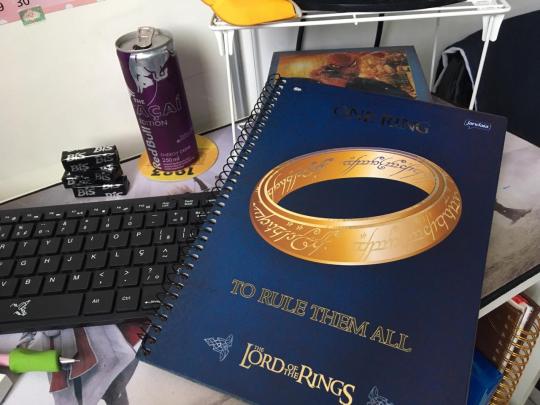

June 14, 2020 [Evening] 14/30 Days of Productivity Today was a good day for my studies! I have started studying at 5 am, as I had to finish what I couldn’t yesterday. I also went to the supermarket wih my husband as our food supplies was almost in the end (I bought this awesome Redbull Açaí, it is a fruit from Brazil with a very particular taste).
In the beggining of the afternoon my mood was bad, I was sad due starting a new week on my job... I don’t like there, I don’t like what I do. Due my former department end, I had to accept a role as bilingual executive assistant or would be fired. As I help my family financially (my side and my husband’s side) I couldn’t refuse, and since April 2019 I am working there, no longer working as a Librarian and I hate this position and all it demands from me: working 9-10 hours per day, somethings on weekends, to answer my corporative phone in inappropriate times... It is extremally heavy.
I was studying for a public office role here in Rio de Janeiro and I found a motivational will in my disgust for were I am working now. You know, I am thankful for being employed, mainly during this pandemic (I am not ungrateful), but I dream with the day that I will leave and never comeback!
So I will study my ass off to get this new job at a public office and with stability, I will do my master degree and all the post-graduation courses that I cannot do now for working so much.
Nothing gonna stop me!
#study#study blog#study space#studying#studyblr#studystudystudy#study plan#study life#dailymotivation#motivational#daily life#dailydiary#dailystuff#dailywomen#i need to be productive#i need to leave my job#post grad problems#working hard#fight for your dreams#study girl#the lord of the rings#stationary#study stationary#stationary lover#lotr#lotr fandom#one ring#nerd stationary#nerdstuff#nerd
3 notes
·
View notes
Text
Alwalkeria maleriensis

By José Carlos Cortés
Etymology: For Alick Walker
First Described By: Chatterjee, 1987
Classification: Dinosauromorpha, Dinosauriformes, Dracohors, Dinosauria, Saurischia
Status: Extinct
Time and Place: Alwalkeria lived about 228 million years ago, in the Carnian age of the Late Triassic


Alwalkeria is known from the Lower member of the Maleri Formation of Andhra Pradesh, India

Physical Description: Alwalkeria is one of the earliest known dinosaurs, so it - like other early dinosaurs - showcases the basic dinosaur body plan: small bipedal runner. It had teeth and a skull very similar to its close cousin, Eoraptor, which had slightly different shapes depending on the position within the jaw and a somewhat small, elongate head. It had straight, slender front teeth, and backwards curved teeth in the back of the jaw, with no serrations. Little more is known about its external appearance, given the lack of remains; however, it probably would have had a long tail, short neck, and long legs and arms. Alwalkeria would probably have been only about a meter long, making it one of the smaller dinosaurs known.
Given its small size and early position on the dinosaur tree, Alwalkeria would most likely have been covered in very primitive protofeathers, but without further fossil evidence this cannot be said for certain.
Diet: Alwalkeria has teeth adapted both for feeding on meat and for feeding on plants, so it was probably an omnivore with a highly variable diet.
Behavior: Alwalkeria would have been a fairly skittish sort of animal, as early dinosaurs such as it were not very big nor very common in their ecosystems. As such, it would have used speed to get away from predators, of which there were many. It would have been curious, as well, due to being an omnivore, and a generalist one at that - so more of an opportunist than anything, looking for sources of food wherever it could.
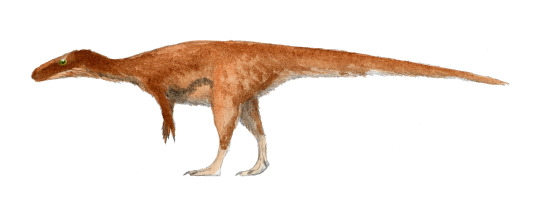
By Ashley Patch
Since it was a dinosaur, like other dinosaurs it would have been a fairly active animal, with a warm-blooded metabolism. It also probably took care of its young.
Ecosystem: Alwalkeria lived near a large lake environment, with mainly ferns present in the region, but also some conifers and horsetails. In the Lower Maleri environment, Alwalkeria lived alongside many other kinds of animals, though no other dinosaurs have been definitively named - only one possible prosauropod. Instead, there were the Cynodonts Exaeretodon, the Phytosaur Parasuchus, the Rhynchosaur Hyperodapedon, the Protorosaur Malerisaurus, the large temnospondyl amphibian Koskinodon, the lungfish Ceratodus, and the freshwater shark Xenacanthus. There may have also been an aetosaur of some sort. Alwalkeria probably mainly fed on small animals such as insects and reptiles not yet found in the fossil record, and it probably mainly had to look out for Koskinodon and Parasuchus in terms of predators.
Other: The original fossils described as Alwalkeria are actually a chimera, with many parts assigned to the genus actually belonging to some sort of early crocodile relative. However, there is an early dinosaur in there too, and that dinosaur seems to primarily resemble Eoraptor, though it hasn’t been thoroughly studied in a phylogenetic analysis. So, that’s what we call Alwalkeria now, even though originally there was more considered to be preserved.
~ By Meig Dickson
Sources under the cut
Angolin, F. L. 2017. Estudio de los Dinosauromorpha (Reptilia, Archosauria) de la Formación Chañares (Triásico Superior), Provincia de la Rioja, Argentina. Sus implicancias en el origen de los Dinosaurios. D. Phil. Thesis, Facultad de Ciencias Naturales y Museo.
Bharadwaj, D. C., S. C. Srivastava, B. V. Ramanamurty, N. Jha. 1986. Palynology of Kamthi Formation from Ramagundam-Mantheni Area, Godavari Graben, Andhra Pradesh, India. The Palaeobotanist 35 (3): 318 - 330.
Chatterjee, S. 1974. A rhynchosaur from the Upper Triassic Maleri Formation of India. Philosophical Transactions of the Royal Society of London, Series B, Biological Sciences 267(884):209-261
Chatterjee, S. 1978. A primitive parasuchid (Phytosaur) reptile from the Upper Triassic Maleri Formation of India. Palaeontology 21(1):83-127
Chatterjee, S. 1980. Malerisaurus, A New Eosuchian Reptile from the Late Triassic of India. Philosophical Transactions of the Royal Society of London, Series B 291:163-200
Chatterjee, S. 1982. A new cynodont reptile from the Triassic of India. Journal of Paleontology 56:203-214
Chatterjee, S., B. Creisler. 1994. Alwalkeria (Theropoda) and Morturneria (Plesiosauria), new names for preoccupied Walkeria Chatterjee, 1987 and Turneria Chatterjee and Small, 1989. Journal of Vertebrate Paleontology 14(1):142
Chowdhury, T. R. 1965. A new metoposaurid amphibian from the Upper Triassic Maleri Formation of central India. 250(761):1-52
Jain, S. L. 1980. Freshwater xenacanthid (= pleuracanth) shark fossils from the Upper Triassic Maleri Formation, India. 21:39-47
Langer, M. C. 2004. Basal Saurischia. In: Weishampel, D. B., P. Dodson, H. Osmolska (ed.). The Dinosauria (2nd Edition). Berkeley: University of California Press: 25 - 46.
Lydekker, R. 1885. The Reptilia & Amphibia of the Maleria & Denwa Groups. 1(5):1-38
Holtz, T. R., L. V. Rey. 2007. Dinosaurs: the most complete, up-to-date encyclopedia for dinosaur lovers of all ages. New York: Random House.
Remes, K., O. W. M. Rauhut. 2005. The oldest Indian Dinosaur Alwalkeria maleriensis Chatterjee revised: a chimera including remains of a basal Saurischian. In Kellner,A. W. A., D. D. R. Henriques, T. Rodrigues (ed.). II Congresso Latino-Americano de Paleontologia de Vertebrados, Boletim de Resumos. Museo Nacional, Rio de Janeiro. 218.
#alwalkeria#alwalkeria maleriensis#dinosaur#saurischian#palaeoblr#omnivore#Mesozoic Monday#India and Madagascar#Triassic#prehistoric life#paleontology#prehistory#factfile#dinosaurs#biology#a dinosaur a day#a-dinosaur-a-day#dinosaur of the day#dinosaur-of-the-day#science#nature
253 notes
·
View notes
Link
Teams of marksmen next year will patrol swaths of Rio de Janeiro with high-powered weapons and a license to kill, said a security adviser to Governor-elect Wilson Witzel.
As many as 120 sharpshooters will accompany police incursions into the slums of Brazil’s postcard city to exterminate gun-toting criminals, according to Flavio Pacca, a longtime associate of Witzel who the governor-elect’s press office said will join the administration. The shooters will work in pairs -- one to pull the trigger, one to monitor conditions and videotape deaths.
“The protocol will be to immediately neutralize, slaughter anyone who has a rifle,” Witzel, a federal judge and former Brazilian marine, told reporters in Brasilia on Dec. 12. “Whoever has a rifle isn’t worried about other people’s lives, they’re ready to eliminate anyone who crosses their path. This is a grave problem, not just in Rio de Janeiro, but also in other states.”
'Like a cancer:' Rio militias grow, control swaths of city
The latest scheme works like this: Brazilian paramilitary groups buy boxes of cigarettes in neighboring Paraguay for 14 cents a pack and then smuggle them back home, where prices and taxes are much higher, and sell them for up to $2.15.
The cigarettes offer the militias the lion’s share of an estimated $330 million in profits and add to a portfolio of illicit operations the groups have honed over two decades, including imposing surcharges on cable service, electricity and transportation. The groups are also known to conduct extortion and summary executions.
But while investigating the smuggled smokes, authorities found other evidence they deemed more troubling: cameras, online monitoring systems and signs of possible connections between militias and members of Red Command, Rio de Janeiro’s most powerful drug gang.
Those, authorities say, are indications that the militia groups which used to be minor players in the Rio underworld are now becoming shot callers — and not easily controlled.
“It’s like a cancer,” anti-piracy police investigator Mauricio Demetrio said. “It won’t stop.”
Beginning in earnest in the 1990s, the militias were mainly made up of former police officers, firefighters and military men who wanted to combat lawlessness in their neighborhoods. For years, they were even lauded by politicians, including President-elect Jair Bolsonaro, a former army captain who as a congressman called for their legalization in 2008.
In theory at least, the groups were helping to confront what the state could not, even if the trade-offs included tolerating illicit businesses and sometimes murder. Along the way, their brutal methods and control expanded. Today some crime experts argue that militias have become Rio’s biggest security threat, with methods that are being copied in other areas of Latin America’s largest nation.
“Militias have a head for business,” said Marcelo Freixo, a state legislator who is accompanied by a half-dozen plainclothes bodyguards because of his work to combat the groups.
Militias, he said, have so completely taken over parts of Rio that confronting them would require gathering street intelligence, deploying state services and using physical force.
“If you just send in troops, you won’t find anybody there,” Freixo said.
Unlike drug traffickers who can be seen brandishing automatic weapons, militia members blend into the background, running things behind the scenes. When necessary, they mobilize in ways that underscore commando-like training: They dress in all black, with faces covered, carry weapons and backpacks, and move in formation.
59 notes
·
View notes
